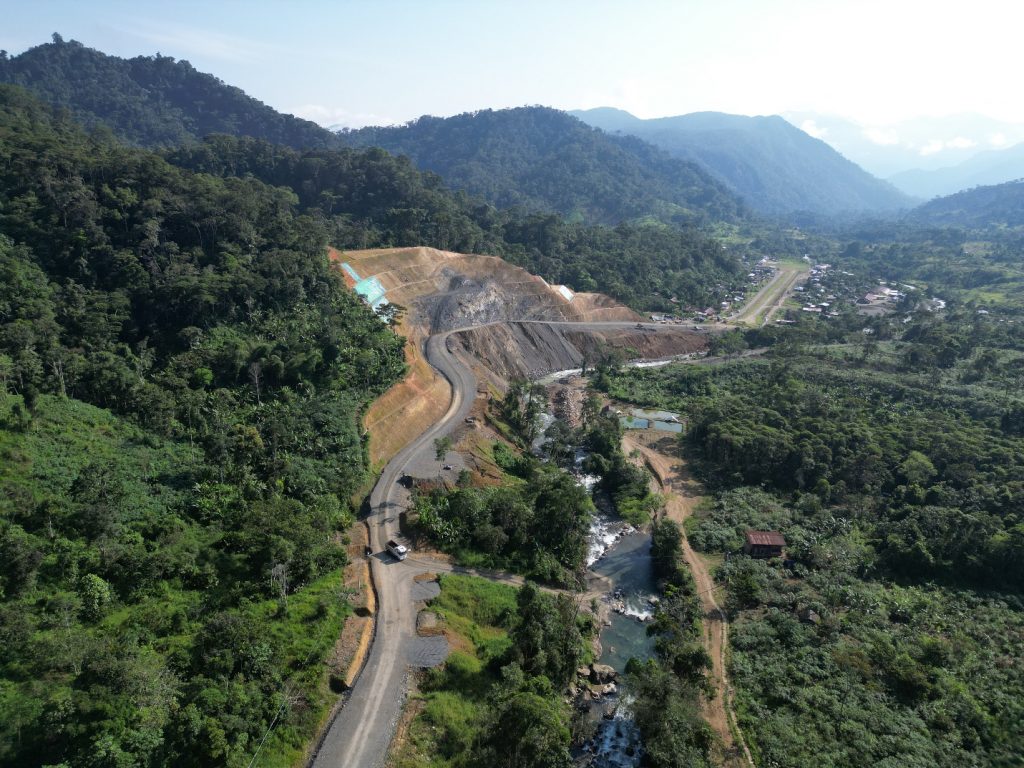
Solaris Resources (TSX:SLS) (NYSEAmerican:SLSR) has released its Consolidated Financial Statements for the years ended December 31, 2024 and 2023, along with Management’s Discussion and Analysis.
The financial statements show that Solaris ended 2024 with cash and cash equivalents of $31,738,000, down from $38,865,000 at the end of 2023. Total current assets decreased to $32,580,000 from $39,388,000 year-over-year.
The company’s total assets stood at $57,196,000 as of December 31, 2024, compared to $61,820,000 at the end of 2023. Property, plant and equipment doubled to $3,866,000 from $1,932,000, while exploration and evaluation assets increased slightly to $20,179,000 from $19,929,000.
Solaris reported a significant increase in total liabilities, which rose to $66,483,000 from $36,394,000 in 2023. Notable changes include:
- Accounts payable and accrued liabilities more than doubled to $12,839,000 from $5,274,000
- Loans and borrowings increased substantially to $49,206,000 from $29,363,000
- Reclamation provision grew to $3,765,000 from $1,529,000
In December 2023, Solaris entered into definitive agreements for a financing package of up to $80,000,000, including a $60,000,000 Senior Loan. To date, the company has received $45,000,000, with the remainder contingent upon meeting certain milestones.
The above references an opinion and is for information purposes only. It is not intended to be investment advice. Seek a licensed professional for investment advice. The author is not an insider or shareholder of any of the companies mentioned above.
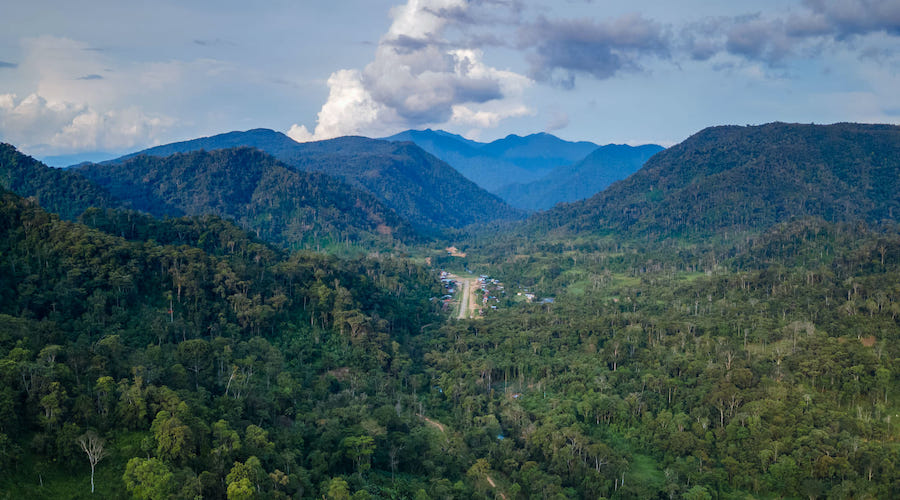
Solaris Resources (TSX:SLS)(NYSEAmerican:SLSR) has announced the formation of an Inter-Institutional working group. This group includes the Pueblo Shuar Arutam organization (PSHA), the host communities of Warints and Yawi, and the Ecuadorian State. The PSHA and its Governing Council have approved and signed a Letter of Intent (LOI) with Solaris.
Matthew Rowlinson, President and CEO commented in a press release: “At Solaris Resources, we believe that sustainable mining is not just an economic endeavour; it is a journey that must include the insights and values of every stakeholder involved, especially our indigenous populations. Their lived experiences and deep connection to the land are vital to shaping responsible mining practices that respect both our natural environment and cultural heritage. As we move forward, its vital we embrace an open dialogue and partnership rooted in trust, understanding, and mutual respect. Together, we continue to create a model for mining that not only drives economic growth but also uplifts our communities and preserves the rich tapestry of the Ecuadorian culture. Thanks to the Pueblo Shuar Arutam organization, and all other stakeholders, for their trust and support as we look to sustainably deliver this Tier 1 asset. This project is for Ecuador, by Ecuador and for the benefit of all stakeholders today, and the generations to come.”
The signing of the LOI occurred on February 5, 2025, at the Yawi Shuar Center. This ratification followed a resolution by the PSHA on January 18, 2025, to form the working group. The PSHA, an indigenous organization in Morona Santiago, operates outside of Solaris’ direct area of influence.
This development builds upon existing agreements between Solaris and the Shuar communities of Warints and Yawi. These communities have an Impacts and Benefits Agreement (IBA) with Solaris. The IBA was initially signed in September 2020, updated in March 2022, and again in April 2024. Solaris also has a trilateral cooperation agreement with the Interprovincial Federation of Shuar Centers (FICSH) and the Alliance for Entrepreneurship and Innovation of Ecuador (AEI).
The Inter-Institutional working group and the LOI aim to facilitate transparent dialogue and workshops. These discussions intend to lead to a future Cooperation Agreement, with the consent of the communities involved.
The PSHA, located in southeast Morona Santiago, comprises nearly ten thousand people organized into 47 Shuar centers.
The existing IBA with Warints and Yawi covers the Warintza Project. It aims to provide community support for the project’s progression from exploration and development to production. The IBA includes commitments to support the communities’ social and cultural practices, mitigate adverse impacts, and provide employment, contracting, and business opportunities. It also includes education, skills training, community infrastructure development, and financial benefits.
The trilateral cooperation agreement with FICSH and AEI, announced in March 2024, aims to promote economic and social development for Shuar communities. This includes health, education, skills training, entrepreneurship, innovation, and sustainable mineral resource development programs. FICSH includes 50 associations, 500 Shuar communities, and approximately 143,000 Shuar indigenous people.
In addition to the LOI, Solaris has concluded its infill drilling program at Warintza. The program included over 75,000 meters of drilling in 2024 and an additional 5,000 meters in early 2025, totaling over 80,000 meters. The primary goal of the drilling was to convert Inferred mineral resources to Measured and Indicated, and to expand uncategorized areas within the pit shell.
The data from this drilling program will form the basis for an updated Mineral Resource Estimate (MRE), expected to be published in mid-2025. This MRE will then be incorporated into the Pre-Feasibility Study (PFS), scheduled for release in Q3 2025.
The above references an opinion and is for information purposes only. It is not intended to be investment advice. Seek a licensed professional for investment advice. The author is not an insider or shareholder of any of the companies mentioned above.
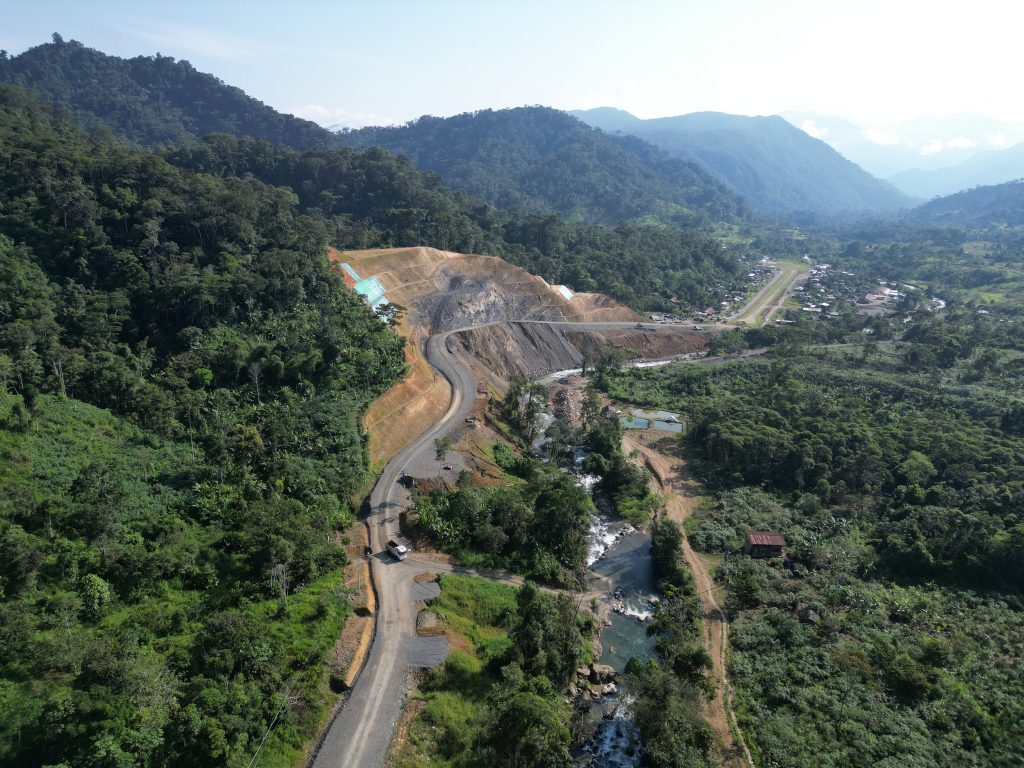
Solaris Resources (TSX:SLS)(NYSEAmerican:SLSR) has announced the expansion of its leadership team with the appointment of three key executives. Richard Hughes has been named Chief Financial Officer and Company Secretary, Patrick Chambers will serve as Vice President of Investor Relations, and Ignacio Shimamoto has been appointed Vice President of Finance. These appointments are effective immediately.
Hughes replaces outgoing CFO Sunny Lowe and will oversee the finance function. His background includes experience as CFO and Executive Director of Trident Royalties PLC, which was recently acquired. Hughes has spent over two decades in the natural resources sector, specializing in strategy, capital markets, and corporate finance.
Chambers will lead global investor engagement, leveraging his geological, investor relations, and business development experience. Over the past 12 years, he has worked with various commodities, focusing on Latin America. Prior to joining Solaris, he served as Head of Investor Relations at Horizonte Minerals.
Shimamoto will manage financial strategy, including internal and external reporting, financial modeling, procurement, and contract management. He has over 20 years of experience in financial planning, acquisitions, and business improvement within the natural resources sector. His previous roles include Finance Manager for Copper Peru at Glencore and Regional Finance Manager overseeing mining operations in Argentina, Chile, and Peru.
Matthew Rowlinson, President and CEO of Solaris, welcomed the new executives and acknowledged the contributions of the outgoing team. “I am delighted to welcome Richard, Patrick, and Ignacio to the management team. Their expertise will be crucial as we continue our strategy to maximize returns for stakeholders. I also extend my gratitude to our outgoing team for their role in establishing the Warintza project as a world-class copper deposit. 2025 is an important year for Solaris as we continue de-risking activities and advancing our projects.”
In connection with his appointment, Hughes has agreed to subscribe for C$350,000 worth of common shares in Solaris through a private placement.
Final Emigration Steps
Solaris has also confirmed that the final steps in its emigration process are complete, pending a few administrative matters. The Company previously provided details on this transition in a news release dated November 20, 2024.
Solaris continues its progress in advancing the Warintza project and strengthening its leadership team as it moves forward with key strategic initiatives.
The above references an opinion and is for information purposes only. It is not intended to be investment advice. Seek a licensed professional for investment advice. The author is not an insider or shareholder of any of the companies mentioned above.
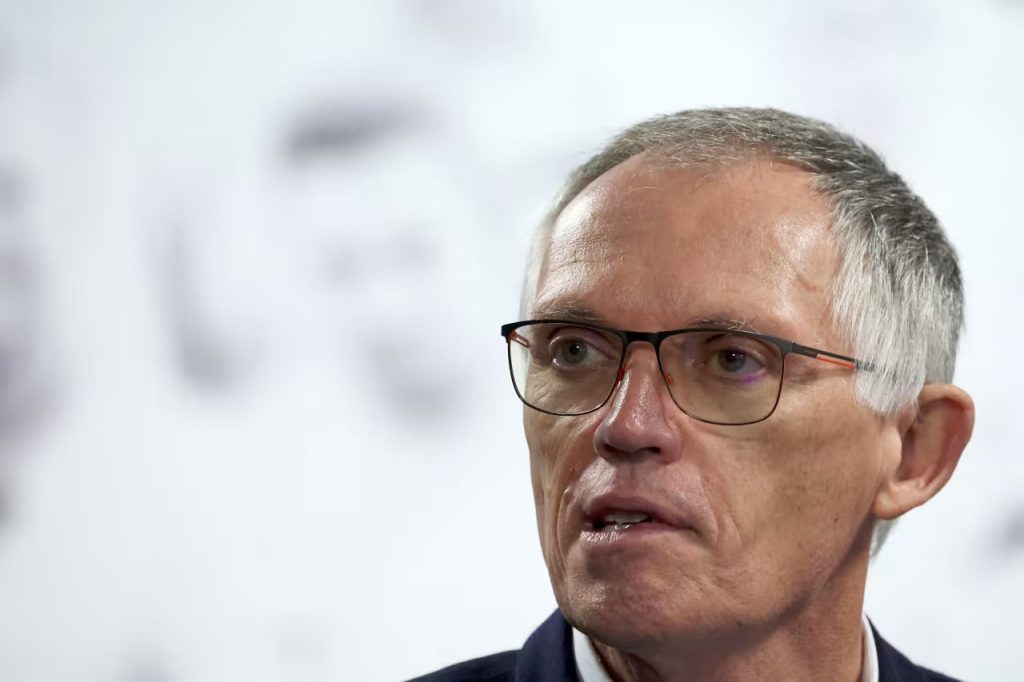
Solaris Resources (TSX:SLS) (NYSEAmerican:SLSR) has appointed Matthew Rowlinson as its President and Chief Executive Officer, effective January 1, 2025. This announcement comes at a pivotal moment for the company as it prepares to finalize its emigration from Canada to Zug, Switzerland, marking a transformative phase in its operational strategy.
Rowlinson brings a wealth of experience to his new role. He has spent over a decade in senior executive positions within Glencore’s copper department, most recently serving as Head of Copper Business Development since 2021. In this capacity, he co-led the strategic management of Glencore’s extensive copper portfolio, one of the largest in the industry. His tenure saw the execution of several high-profile mergers and acquisitions, including Glencore’s consolidation of the MARA project, a deal that underscored his expertise in navigating complex transactions and optimizing asset value.
The Strategic Shift to Switzerland
Solaris Resources’ decision to relocate its headquarters to Zug, Switzerland, is aimed at enhancing shareholder value and aligning with Ecuadorian regulatory frameworks. The move coincides with the advancement of the Warintza Project, the company’s flagship asset, which is progressing through the permitting phase. By relocating, Solaris seeks to position itself more advantageously in the global market, facilitating future growth and operational efficiency. The new base in Switzerland, known for its favorable business environment and strategic location, is expected to provide the company with enhanced opportunities for international expansion and investment.
The transition to Switzerland also reflects a broader strategy to optimize the company’s structure and operations. Alongside this relocation, Solaris plans to execute a spin-out transaction to capitalize on its non-core assets, including La Verde, Capricho, and Paco Orco. The spin-out will form a new growth-oriented copper company focused on consolidating operating and advanced development assets. With Rowlinson at the helm, this new venture is poised to leverage his extensive industry knowledge and network to drive rapid scaling and unlock significant value.
Board and Leadership Changes
Rowlinson’s appointment is part of a comprehensive leadership overhaul at Solaris. He will join the company’s board of directors, alongside Rodrigo Borja and Hans Wick, as of January 1, 2025. At the same time, Canadian directors Daniel Earle, Poonam Puri, Kevin Thomson, and Ron Walsh will step down. This realignment reflects the company’s commitment to assembling a leadership team that aligns with its new strategic direction.
In addition to his role as CEO, Rowlinson has agreed to invest C$500,000 in Solaris shares through a private placement, demonstrating his confidence in the company’s potential and aligning his interests with those of shareholders.
Implications for the Copper Market
Rowlinson’s appointment and Solaris’ strategic realignment come at a time of growing global demand for copper. As a critical material for electrification and renewable energy technologies, copper is needed for the transition to a low-carbon economy. With its flagship Warintza Project and a portfolio of high-potential assets, Solaris is well-positioned to capitalize on this demand.
Under Rowlinson’s leadership, the company will focus on advancing the Warintza Project while exploring acquisition opportunities that align with its growth strategy. His track record at Glencore demonstrates an ability to identify and execute value-accretive transactions, a skill set that will be invaluable to Solaris Resources.
Enhancing Shareholder Value
The relocation to Switzerland and the planned spin-out are expected to unlock significant value for Solaris shareholders. By streamlining its operations and focusing on core assets, the company aims to enhance its financial performance and market positioning. The spin-out of non-core assets into a separate entity will allow Solaris to concentrate its resources on advancing the Warintza Project while providing investors with exposure to a new growth-oriented copper company.
The move to Switzerland will also facilitate potential acquisition transactions by positioning Solaris in a jurisdiction known for its strong legal and financial frameworks. This strategic shift enhances the company’s ability to attract investment and execute complex deals.
Matthew Rowlinson’s appointment as CEO marks a turning point for Solaris Resources. His extensive experience, proven leadership, and strategic acumen are expected to drive the company’s growth and transformation as Solaris completes its relocation to Switzerland and advances its key projects.
The above references an opinion and is for information purposes only. It is not intended to be investment advice. Seek a licensed professional for investment advice. The author is not an insider or shareholder of any of the companies mentioned above.

Solaris Resources (TSX:SLS) has finished a year of major change and progress in 2024, with advancements at its flagship Warintza Project in Ecuador, a strategic move out of Canada, and a new leadership team set to guide the company into its next phase of growth. Let’s take a look back at some of the developments that shaped Solaris Resources’ year, with a particular focus on the implications of the upcoming emigration to Ecuador.
Warintza Project: Advancing Towards Production
The Warintza Project remained the focal point of Solaris Resources’ mining plan throughout 2024. The company maintained an aggressive exploration and resource definition drilling program, exceeding its initial target of 60,000 meters and ultimately drilling over 75,000 meters by year-end . This ambitious campaign showed encouraging results, with drill holes consistently intersecting high-grade copper mineralization and expanding the known resource . Importantly, holes SLS-111 and SLS-107 returned impressive intercepts of 90 meters of 1.12% CuEq and 96 meters of 0.82% CuEq from surface, respectively, further highlighting the project’s continued potential.
Beyond drilling, Solaris Resources made progress in developing critical infrastructure at Warintza, including improving road access, expanding the on-site camp, and initiating early works construction. These efforts support ongoing exploration, facilitating future feasibility studies, and ultimately enabling mine construction.
Solaris Resources also demonstrated its commitment to responsible mining practices and community engagement. The company signed an updated Impact and Benefits Agreement with local communities, outlining commitments to social and economic development programs. This agreement underscores Solaris’ dedication to sharing the benefits of the Warintza Project with local stakeholders and fostering positive relationships.
Emigration to Ecuador
In a move that surprised, Solaris Resources announced its decision to emigrate from Canada to Ecuador by the end of 2024. This strategic decision reflects the company’s need to align itself more closely with Ecuadorian regulators, optimize its corporate structure for the development of Warintza, and potentially benefit from a more favorable tax environment.
The emigration process involved several key steps, including management and board changes. Effective January 1, 2025, Matthew Rowlinson, former Head of Copper Business Development at Glencore, will take over as President and CEO. Rowlinson brings a wealth of experience in the copper mining industry, mergers and acquisitions, and project development, making him a valuable asset as Solaris Resources navigates the challenges and opportunities in Ecuador.
Concurrent with the CEO change, Solaris Resources also announced changes to its board of directors, with Rowlinson, Rodrigo Borja, and Hans Wick joining the board, while Canadian directors Daniel Earle, Poonam Puri, Kevin Thomson, and Ron Walsh will step down. These changes reflect the company’s commitment to aligning its leadership with its new corporate structure and strategic focus in Ecuador.
New Leadership, New Opportunities: The Potential for Zijin Mining
The appointment of Matthew Rowlinson as CEO and the company’s emigration to Ecuador could also change the company’s relationship with Zijin Mining Group. Earlier in the year, Solaris Resources terminated a proposed $130 million strategic investment from Zijin after the deal faced regulatory hurdles and delays in Canada. However, with Solaris Resources based in Ecuador and under new leadership, the possibility of reviving the transaction or exploring alternative forms of collaboration with Zijin remains open.
Zijin, a leading global mining company with extensive experience in copper development, could provide valuable technical expertise and financial resources to support the Warintza Project. A renewed partnership with Zijin could accelerate the project’s development timeline and enhance long-term prospects.
Looking Ahead to 2025
As Solaris Resources begins this new chapter, the company must manage the changing regulatory rules in Ecuador, manage relationships with local communities and stakeholders, and effectively execute its development plans for Warintza. The new leadership team’s experience and expertise will be absolutely critical in addressing these and capitalizing on the growing demand for copper.
The company’s stock price experienced some volatility throughout 2024, influenced by external factors. Now with a renewed focus on Ecuador, a strong leadership team, and the potential for renewed collaboration with Zijin Mining, Solaris Resources is gearing up to unlock the full value of its assets and deliver strong returns for all stakeholders in 2025.
The above references an opinion and is for information purposes only. It is not intended to be investment advice. Seek a licensed professional for investment advice. The author is not an insider or shareholder of any of the companies mentioned above.

Solaris Resources (TSX:SLS)(NYSEAmerican:SLSR) has announced final steps to complete its emigration from Canada by the end of the year. The move aims to enhance shareholder returns and align the company with Ecuadorian regulatory frameworks as the Warintza Project progresses through permitting.
Leadership Changes
Matthew Rowlinson will assume the roles of President and Chief Executive Officer on January 1, 2025. He will operate out of Solaris’ new office in Zug, Switzerland, where additional staff appointments are expected. Rowlinson, previously Head of Copper Business Development at Glencore, brings extensive experience in copper mining, mergers, and acquisitions. His leadership is seen as pivotal for Solaris’ future endeavors.
The board of directors will also undergo significant changes. Effective January 1, 2025, Rowlinson, along with Rodrigo Borja and Hans Wick, will join the board. Concurrently, Canadian directors Daniel Earle, Poonam Puri, Kevin Thomson, and Ron Walsh will step down.
Mr. Richard Warke, Executive Chairman of Solaris, commented in a press release: “I want to offer my sincerest gratitude to the Solaris team for their unrelenting drive to advance the late David Lowell’s greenfield discovery at Warintza to become a major copper project more than ten-times its original size in only five years. As early works infrastructure development is now underway, this team has brought Warintza within view of completing permitting and commencing full-scale construction for what could be one of the industry’s last major copper districts to be developed at low elevation and adjacent to infrastructure. I would also like to thank the outgoing directors for their guidance during this journey. I am firmly committed to maximizing returns for shareholders and protecting the interests of stakeholders and this reorganization creates the strategic flexibility and alignment of interests with regulators to do so. I want to welcome Matt and the incoming directors to Solaris as we position ourselves for a pivotal year ahead.”
Solaris has bolstered its technical and operational capacity in South America. Chief Operating Officer Javier Toro leads a Lima-based team that includes experts from senior copper mining companies. In Ecuador, long-standing executives Jorge Fierro and Ricardo Obando will oversee exploration and community affairs, respectively. Obando’s recent promotion reflects his expertise in social and government relations.
Spin-Out Plans
The company is preparing a spin-out of its non-core assets, including La Verde, Capricho, and Paco Orco. This new entity, set to launch in 2025, will focus on acquiring and developing copper projects with significant growth potential. Rowlinson’s experience and network are expected to support the rapid scaling of this new venture.
Solaris will close its Canadian offices by January 1, 2025, completing its emigration process. The company will cease Canadian operations and relocate its assets and personnel outside Canada. Solaris expects no adverse tax or stock exchange implications from this transition.
Rowlinson’s tenure at Glencore saw him managing a significant copper portfolio and leading key acquisitions, including the MARA project. Borja, a senior lawyer, has extensive experience in Ecuador’s mining and oil sectors. Wick, with a background in banking and mining investments, adds financial expertise to the board. Obando, promoted to Vice President of Community and Government Affairs, has a history of facilitating social and government relations in Ecuador.
The above references an opinion and is for information purposes only. It is not intended to be investment advice. Seek a licensed professional for investment advice. The author is not an insider or shareholder of any of the companies mentioned above.



Solaris Resources (TSX:SLS)(NYSEAmerican:SLSR) has released an operational update for its Warintza Project, a copper-gold-molybdenum deposit located in southeastern Ecuador. The update highlights progress in drilling, infrastructure development, and technical programs that support the project’s advancement. Solaris’ 2024 drilling program has already surpassed expectations, and its early infrastructure projects are underway for streamlined access and logistics.
Drilling Update
Solaris has exceeded its original drilling target, completing 60,000 meters of drilling by the end of October. As part of its ambitious plans, the company now expects to surpass 75,000 meters by the end of the year. Currently, nine drilling rigs are in operation at Warintza, primarily focused on the extension and infill drilling needed for the 2024 Mineral Resource Estimate (MRE). This drilling work extends beyond the resource boundary to Warintza West, an area outside the MRE that may yield further resource growth in an expanded open-pit layout.
The drilling program is pivotal to defining and expanding the Warintza resource. By incorporating data from Warintza West, Solaris hopes to broaden the scope of the project, which could enhance the economic potential of the Warintza site. As results continue to emerge, the company is aiming to build a robust geological model to support future mining plans.
Solaris has upgraded 25 kilometers of road connecting the project to Ecuador’s highway network, improving transportation efficiency. An additional 8 kilometers of new roads were constructed to facilitate the logistics of drilling activities. This infrastructure supports ongoing mobilization, ensuring a smoother process for bringing materials and personnel to the site.
Construction efforts have also extended to a further 7 kilometers of roads. These roads are part of a long-term plan designed to support future mining operations. They will provide access to key project areas, including planned locations for the process plant, Waste Rock Facility (WRF), Tailings Management Facility (TMF), and anticipated pre-stripping and drilling zones.
By establishing this infrastructure early, Solaris aims to reduce potential bottlenecks as the project advances. The expanded road network will enhance logistics and access for future operational phases, helping to streamline the mining process and reduce downtime due to logistical constraints.
Technical Programs
Solaris has also reported advances in technical programs integral to the project’s development. Geotechnical and hydrogeological work has been completed for the TMF, with additional studies underway for the anticipated open pit, WRF, process plant, and related infrastructure. These programs include field testing, sampling, and instrumentation installations to ensure that future operations adhere to safety and environmental standards.
Knight Piésold Consulting, a firm specializing in engineering for mining and environmental projects, is finalizing studies on the TMF. These studies will form a crucial part of the upcoming Environmental Impact Assessment (EIA) review period. Final reports, including essential data on water management, are expected within the next few weeks. Once finalized, these reports will serve as key documents to support regulatory reviews.
In parallel with drilling and infrastructure development, Solaris has continued its metallurgical and processing studies. A recent metallurgical drilling program has been completed to supplement prior testing results. Comminution testing has also been finalized, providing a clearer picture of the deposit’s hardness. The upper layers of the deposit show a reduced hardness level compared to earlier expectations, potentially impacting the approach to extraction and processing.
The company is now moving forward with additional flotation tests. These tests aim to optimize reagents to improve copper and molybdenum recovery rates. Completion of these tests is anticipated by the end of the year, marking a significant milestone in Solaris’ efforts to refine its processing techniques.
Ausenco Engineering, a firm working closely with Solaris on the process plant design, has developed a preliminary flowsheet for the plant. This preliminary design is built on previous test work, which indicated that Warintza’s ores can yield high-quality concentrates for copper, gold, and molybdenum. These concentrates are expected to align well with the project’s economic goals, making the design a promising blueprint for Warintza’s processing infrastructure.
Looking Ahead
As Solaris Resources advances its Warintza Project, it is on track to meet or exceed its goals for 2024. With drilling activities well ahead of schedule and critical infrastructure nearing completion, Solaris has positioned itself to begin more detailed planning and development phases. Technical reports from Knight Piésold Consulting, as well as the results of ongoing metallurgical studies, will contribute to the EIA process, which is essential for Solaris to obtain the necessary permits for future operations.
The upcoming months will focus on analyzing additional drilling data and fine-tuning processing methodologies. As the company approaches the year-end, Solaris plans to evaluate the findings from Warintza West, which could play a significant role in expanding the project’s scope. With substantial groundwork laid in infrastructure, technical analysis, and processing design, Solaris appears to be progressing steadily toward developing the Warintza Project into a major mining operation.
Assay results from the company’s most recent update are as follows:


Drill results continue to build on the MRE, with holes SLS-111 and SLS-107 improving upon the modelled grade in its vicinity, while holes SLS 110, SLS 113-116 and SLSE-64 encountered mineralization partially outside of the MRE in the southern and northeastern sectors.
- SLS-111 (drilled southeast): 90m of 1.12% CuEq² within 475m of 0.46% CuEq² from surface
- SLS-107 (drilled northeast): 96m of 0.82% CuEq² within 543m of 0.51% CuEq² from surface
Step-out exploration drilling to the northwest of the MRE testing its connection to the Warintza West deposit has been completed with assays expected in the coming weeks, representing an opportunity for expansion of the MRE in an enlarged pit.
Table 1 – Mineral Resource Extension, Infill and Condemnation Results
| Hole ID | Date Reported |
From (m) |
To (m) |
Interval (m) |
Cu (%) |
Mo (%) |
Au (g/t) |
CuEq² (%) |
Comments |
| SLS-116 | Nov 12, 2024 | 0 | 475 | 475 | 0.22 | 0.00 | 0.02 | 0.23 | Southern sector – Infill / Extensional |
| Including | 12 | 108 | 96 | 0.41 | 0.00 | 0.02 | 0.42 | ||
| Including | 12 | 252 | 240 | 0.29 | 0.00 | 0.02 | 0.31 | ||
| SLS-115 | 0 | 469 | 469 | 0.23 | 0.00 | 0.03 | 0.25 | Southern sector – Infill / Extensional | |
| Including | 42 | 249 | 207 | 0.36 | 0.00 | 0.02 | 0.38 | ||
| Including | 42 | 393 | 351 | 0.28 | 0.00 | 0.03 | 0.30 | ||
| SLS-114 | 0 | 563 | 563 | 0.21 | 0.00 | 0.03 | 0.24 | Southern sector – Infill / Extensional | |
| Including | 63 | 563 | 500 | 0.24 | 0.00 | 0.03 | 0.26 | ||
| Including | 96 | 165 | 69 | 0.49 | 0.00 | 0.02 | 0.50 | ||
| Including | 96 | 309 | 213 | 0.31 | 0.00 | 0.02 | 0.33 | ||
| SLS-113 | 0 | 656 | 656 | 0.17 | 0.00 | 0.03 | 0.19 | Southern sector – Infill / Extensional | |
| Including | 117 | 375 | 258 | 0.25 | 0.00 | 0.03 | 0.27 | ||
| Including | 159 | 342 | 183 | 0.31 | 0.00 | 0.03 | 0.33 | ||
| Including | 342 | 656 | 314 | 0.14 | 0.00 | 0.03 | 0.17 | ||
| SLS-111 | 0 | 475 | 475 | 0.36 | 0.01 | 0.04 | 0.46 | Central sector – infill | |
| Including | 0 | 384 | 384 | 0.43 | 0.01 | 0.05 | 0.54 | ||
| Including | 60 | 150 | 90 | 0.99 | 0.02 | 0.06 | 1.12 | ||
| Including | 60 | 243 | 183 | 0.70 | 0.02 | 0.05 | 0.83 | ||
| SLS-110 | 0 | 671 | 671 | 0.13 | 0.00 | 0.02 | 0.15 | Southern sector – Infill / Extensional | |
| Including | 117 | 303 | 186 | 0.22 | 0.00 | 0.02 | 0.24 | ||
| Including | 117 | 671 | 554 | 0.14 | 0.00 | 0.02 | 0.16 | ||
| SLS-108 | 0 | 513 | 513 | 0.48 | 0.02 | 0.04 | 0.63 | Central sector – Infill | |
| Including | 0 | 435 | 435 | 0.49 | 0.02 | 0.04 | 0.65 | ||
| Including | 228 | 303 | 75 | 0.68 | 0.02 | 0.04 | 0.81 | ||
| SLS-107 | 0 | 543 | 543 | 0.26 | 0.04 | 0.05 | 0.51 | Northwest sector – Infill | |
| Including | 0 | 96 | 96 | 0.62 | 0.03 | 0.09 | 0.82 | ||
| Including | 0 | 147 | 147 | 0.42 | 0.04 | 0.08 | 0.68 | ||
| Including | 204 | 543 | 339 | 0.23 | 0.04 | 0.04 | 0.47 | ||
| SLS-106 | 0 | 230 | 230 | 0.18 | 0.03 | 0.04 | 0.39 | Northwest sector – Infill | |
| Including | 0 | 204 | 204 | 0.19 | 0.04 | 0.04 | 0.42 | ||
| Including | 42 | 90 | 48 | 0.39 | 0.04 | 0.05 | 0.65 | ||
| Including | 42 | 138 | 96 | 0.30 | 0.04 | 0.04 | 0.53 | ||
| SLS-105 | 0 | 323 | 323 | 0.19 | 0.03 | 0.04 | 0.37 | Northwest sector – Infill | |
| Including | 0 | 210 | 210 | 0.22 | 0.04 | 0.04 | 0.45 | ||
| Including | 42 | 111 | 69 | 0.37 | 0.05 | 0.04 | 0.68 | ||
| SLSE-70 | 0 | 394 | 394 | 0.38 | 0.01 | 0.06 | 0.49 | Eastern sector – Infill | |
| Including | 24 | 99 | 75 | 0.60 | 0.01 | 0.05 | 0.71 | ||
| Including | 24 | 210 | 186 | 0.44 | 0.02 | 0.05 | 0.56 | ||
| Including | 210 | 394 | 184 | 0.35 | 0.01 | 0.07 | 0.47 | ||
| SLSE-69 | 0 | 208 | 208 | 0.07 | 0.00 | 0.02 | 0.10 | Eastern sector – Condemnation | |
| SLSE-64 | 0 | 391 | 391 | 0.10 | 0.00 | 0.02 | 0.14 | Northeast sector – Infill / Extensional | |
| SLSE-63 | 0 | 251 | 251 | 0.09 | 0.00 | 0.03 | 0.12 | Northeast sector – Condemnation | |
| SLSE-59 | 0 | 410 | 410 | 0.09 | 0.00 | 0.02 | 0.12 | Northeast sector – Condemnation | |
| SLST-06 | 0 | 200 | 200 | 0.10 | 0.00 | 0.05 | 0.13 | Southern sector – Infill | |
| SLST-05 | 0 | 400 | 400 | 0.10 | 0.00 | 0.03 | 0.13 | Southern sector – Infill | |
| SLST-04 | 0 | 500 | 500 | 0.10 | 0.00 | 0.04 | 0.13 | Southern sector – Infill |
Notes to Table 1: True widths are interpreted to be very close to drilled widths due to the bulk-porphyry style mineralized zones at Warintza.
Table 2 – Collar Locations
| Hole ID | Easting | Northing | Elevation (m) |
Depth (m) |
Azimuth (degrees) |
Dip (degrees) |
| SLS-116 | 800,241 | 9,647,745 | 1,710 | 475 | 243 | -74 |
| SLS-115 | 800,239 | 9,647,740 | 1,710 | 469 | 240 | -46 |
| SLS-114 | 800,235 | 9,647,740 | 1,709 | 563 | 66 | -71 |
| SLS-113 | 800,239 | 9,647,739 | 1,710 | 656 | 61 | -48 |
| SLS-111 | 800,385 | 9,648,301 | 1,411 | 475 | 117 | -55 |
| SLS-110 | 800,235 | 9,647,735 | 1,707 | 671 | 38 | -54 |
| SLS-108 | 800,383 | 9,648,303 | 1,411 | 513 | 180 | -65 |
| SLS-107 | 799,760 | 9,648,031 | 1,575 | 543 | 45 | -60 |
| SLS-106 | 799,567 | 9,648,148 | 1,402 | 230 | 233 | -46 |
| SLS-105 | 799,568 | 9,648,147 | 1,403 | 323 | 220 | -60 |
| SLSE-70 | 801,262 | 9,648,122 | 1,282 | 394 | 90 | -87 |
| SLSE-69 | 801,710 | 9,647,937 | 1,199 | 208 | 65 | -62 |
| SLSE-64 | 801,799 | 9,648,247 | 1,101 | 391 | 300 | -50 |
| SLSE-63 | 801,805 | 9,648,237 | 1,099 | 251 | 270 | -76 |
| SLSE-59 | 801,160 | 9,648,332 | 1,313 | 410 | 62 | -68 |
| SLST-06 | 800,210 | 9,647,529 | 1,601 | 200 | 90 | -47 |
| SLST-05 | 800,201 | 9,647,526 | 1,599 | 400 | 250 | -60 |
| SLST-04 | 800,207 | 9,647,528 | 1,600 | 500 | 0 | -80 |
Notes to Table 2: The coordinates are in WGS84 17S Datum.
Endnotes
- Refer to the technical report entitled “Mineral Resource Estimate Update – NI 43-101 Technical Report, Warintza Project, Ecuador” with an effective date of July 1, 2024 and available on SEDAR+ under the Company’s profile at www.sedarplus.ca and on the Company’s website.
- Copper-equivalence grade calculation for reporting assumes metal prices of US$4.00/lb Cu, US$20.00/lb Mo, and US$1,850/oz Au, and recoveries of 90% Cu, 85% Mo, and 70% Au based on preliminary metallurgical testwork. CuEq formula: CuEq (%) = Cu (%) + 5.604 × Mo (%) + 0.623 × Au (g/t).
The above references an opinion and is for information purposes only. It is not intended to be investment advice. Seek a licensed professional for investment advice. The author is not an insider or shareholder of any of the companies mentioned above.
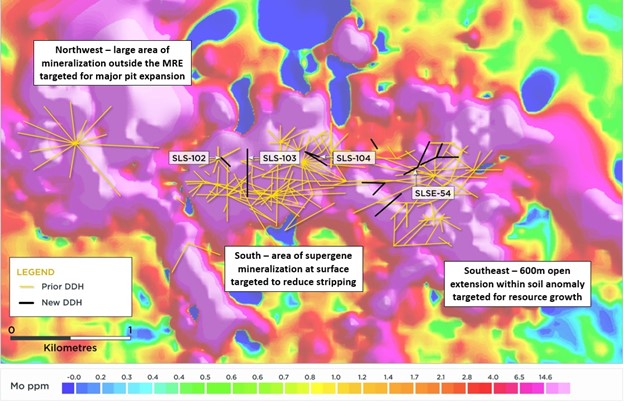

Solaris Resources (TSX:SLS) (NYSEAmerican:SLSR) has announced assay results from its ongoing 2024 drilling program at the Warintza Project in southeastern Ecuador. The results reveal high-grade mineralization near the surface, improving previously modeled grades and expanding the potential of the resource in several key areas of the site.
The company, which has drilled over 53,000 meters by the end of the third quarter of 2024, is aiming to exceed its 60,000-meter target for the year. The latest drill holes, SLS-103, SLSE-54, SLS-102, and SLSE-52, add significant mineralization in areas that had not been extensively drilled. Holes SLS-103 and SLSE-54, located in the northwest and northeast sectors, respectively, have intersected new high-grade mineralization at surface, with much of the mineralization falling outside the current Mineral Resource Estimate (MRE). This marks an important step in expanding the known resource, as these results indicate higher grades than previously modeled in these regions.
Key intercepts include 87 meters of 1.23% CuEq, 93 meters of 1.01% CuEq, and 84 meters of 1.00% CuEq. These findings bolster the company’s ongoing efforts to improve the quality of the resource, particularly in sparsely drilled zones within the northwest, north, and northeast areas of the project.
In addition to the resource expansion efforts, Solaris is conducting exploration drilling in an area featuring a large soil anomaly on the opposite side of a granodiorite formation, which shapes the northwestern pit wall. Assays from this exploration are expected in the coming weeks.
With high productivity on-site due to infrastructure investments, Solaris remains on track to exceed its 2024 drilling plan. Current efforts include drilling focused on expanding open extensions of the resource, infill drilling to upgrade existing resources, and further geotechnical and condemnation drilling.
Highlights from the results include:
Northwest, North and Northeast Sectors:
- SLS-102 (drilled northwest): 93m of 1.01% CuEq² within 156m of 0.74% CuEq² from surface
- SLS-103 (drilled north): 87m of 1.23% CuEq² within 528m of 0.59% CuEq² from surface
- SLS-104 (drilled southeast): 84m of 1.00% CuEq² within 485m of 0.77% CuEq² from surface
- SLSE-54 (drilled southwest): 258m of 0.52% CuEq² within 399m of 0.41% CuEq² from surface
Table 1 – Mineral Resource Extension, Infill and Condemnation Results
| Hole ID | Date Reported |
From (m) |
To (m) |
Interval (m) |
Cu (%) |
Mo (%) |
Au (g/t) |
CuEq² (%) |
Comments |
| SLS-104 | Oct 7, 2024 | 0 | 485 | 485 | 0.56 | 0.03 | 0.06 | 0.77 | Northern sector – infill |
| Including | 45 | 129 | 84 | 0.82 | 0.02 | 0.07 | 1.00 | ||
| Including | 45 | 255 | 210 | 0.69 | 0.03 | 0.07 | 0.90 | ||
| Including | 45 | 485 | 440 | 0.61 | 0.03 | 0.06 | 0.82 | ||
| SLS-103 | 0 | 528 | 528 | 0.26 | 0.05 | 0.04 | 0.59 | Northwest sector – infill and extensional | |
| Including | 21 | 108 | 87 | 1.00 | 0.03 | 0.11 | 1.23 | ||
| Including | 21 | 483 | 462 | 0.29 | 0.06 | 0.05 | 0.64 | ||
| Including | 240 | 345 | 105 | 0.28 | 0.08 | 0.02 | 0.72 | ||
| SLS-102 | 0 | 156 | 156 | 0.46 | 0.04 | 0.08 | 0.74 | Northwest sector – infill | |
| Including | 57 | 150 | 93 | 0.73 | 0.04 | 0.09 | 1.01 | ||
| SLS-101 | 0 | 307 | 307 | 0.06 | 0.01 | 0.02 | 0.14 | Northwest sector – condemnation | |
| SLSE-60 | 0 | 290 | 290 | 0.16 | 0.01 | 0.03 | 0.23 | Northeast sector – infill | |
| Including | 93 | 290 | 197 | 0.21 | 0.01 | 0.04 | 0.30 | ||
| Including | 141 | 290 | 149 | 0.24 | 0.01 | 0.05 | 0.35 | ||
| Including | 207 | 290 | 83 | 0.28 | 0.02 | 0.03 | 0.43 | ||
| SLSE-58 | 0 | 453 | 453 | 0.03 | 0.00 | 0.01 | 0.04 | Northeast sector – condemnation | |
| SLSE-57 | 0 | 660 | 660 | 0.22 | 0.01 | 0.05 | 0.30 | Southeast sector – extensional | |
| Including | 552 | 660 | 108 | 0.49 | 0.02 | 0.06 | 0.61 | ||
| SLSE-56 | 0 | 381 | 381 | 0.09 | 0.00 | 0.03 | 0.11 | Northeast sector – condemnation | |
| SLSE-55 | 0 | 473 | 473 | 0.12 | 0.00 | 0.02 | 0.16 | Northeast sector – condemnation | |
| SLSE-54 | 0 | 399 | 399 | 0.29 | 0.01 | 0.04 | 0.41 | Northeast sector – infill and extensional | |
| Including | 0 | 258 | 258 | 0.37 | 0.02 | 0.05 | 0.52 | ||
| Including | 81 | 231 | 150 | 0.43 | 0.02 | 0.05 | 0.60 | ||
| SLSE-53 | 0 | 455 | 455 | 0.04 | 0.00 | 0.02 | 0.07 | Northeast sector – condemnation | |
| SLSE-52 | 0 | 138 | 138 | 0.15 | 0.01 | 0.03 | 0.23 | Southeast sector – condemnation | |
| SLSE-51 | 0 | 257 | 257 | 0.15 | 0.01 | 0.03 | 0.20 | Southeast sector – condemnation |
Notes to Table 1: True widths are interpreted to be very close to drilled widths due to the bulk-porphyry style mineralized zones at Warintza.
Table 2 – Collar Locations
| Hole ID | Easting | Northing | Elevation (m) |
Depth (m) |
Azimuth (degrees) | Dip (degrees) |
| SLS-104 | 800383 | 9648303 | 1411 | 485 | 110 | -70 |
| SLS-103 | 799760 | 9648031 | 1575 | 528 | 360 | -56 |
| SLS-102 | 799568 | 9648147 | 1403 | 253 | 315 | -60 |
| SLS-101 | 799760 | 9648031 | 1575 | 307 | 180 | -45 |
| SLSE-60 | 801800 | 9648235 | 1102 | 290 | 243 | -54 |
| SLSE-58 | 801806 | 9648243 | 1098 | 454 | 90 | -58 |
| SLSE-57 | 801150 | 9647610 | 1396 | 660 | 45 | -60 |
| SLSE-56 | 801163 | 9648335 | 1309 | 382 | 326 | -71 |
| SLSE-55 | 801597 | 9648134 | 1155 | 473 | 25 | -50 |
| SLSE-54 | 801596 | 9648136 | 1154 | 481 | 240 | -70 |
| SLSE-53 | 801802 | 9648239 | 1100 | 455 | 23 | -68 |
| SLSE-52 | 801248 | 9647968 | 1252 | 354 | 270 | -46 |
| SLSE-51 | 801246 | 9647967 | 1252 | 257 | 225 | -45 |
Notes to Table 2: The coordinates are in WGS84 17S Datum.
Endnotes
- Refer to the technical report entitled “Mineral Resource Estimate Update – NI 43-101 Technical Report, Warintza Project, Ecuador” with an effective date of July 1, 2024 and available on SEDAR+ under the Company’s profile at www.sedarplus.ca and on the Company’s website.
- Copper-equivalence grade calculation for reporting assumes metal prices of US$4.00/lb Cu, US$20.00/lb Mo, and US$1,850/oz Au, and recoveries of 90% Cu, 85% Mo, and 70% Au based on preliminary metallurgical testwork. CuEq formula: CuEq (%) = Cu (%) + 5.604 × Mo (%) + 0.623 × Au (g/t).
The above references an opinion and is for information purposes only. It is not intended to be investment advice. Seek a licensed professional for investment advice. The author is not an insider or shareholder of any of the companies mentioned above.


Solaris Resources (TSX:SLS) (NYSEAmerican:SLSR) has announced drilling results from its ongoing exploration program at the Warintza Project in southeastern Ecuador. The company aims to expand mineral resources and upgrade existing ones while enhancing its infrastructure and operational efficiency. The latest update provides insight into the progress made through new assay results and a record-breaking month for drilling activity.
Solaris announced the latest results of its 2024 drilling campaign, which includes a planned total of 60,000 meters. The key findings from recent drilling operations highlight intercepts of high-grade mineralization that extend beyond the current Mineral Resource Estimate (MRE). These findings emerged from drill holes in the northwest and southeast sectors of the Warintza Project, targeting sparsely drilled zones where grades have historically been lower or less understood.
A standout result from the latest drilling includes an intercept measuring 475 meters at a copper-equivalent grade (CuEq) of 1.03%. This intercept came from near the surface and demonstrated the potential to significantly expand the existing resource base. This mineralization is essential for refining the geological model of the Warintza Project and providing a stronger basis for future resource upgrades.
The company also achieved a new drilling record in August 2024. Solaris reported that its team drilled 10 kilometers (km) in one month, surpassing a previous record set in 2021 when 12 rigs managed to drill 8 km. The current 10 km of drilling was achieved using just eight rigs, indicating considerable improvements in productivity and operational efficiency. This record sets the company on a strong trajectory toward completing its 60,000-meter drilling goal for the year, further advancing the exploration potential of Warintza.
Solaris attributes this increase in productivity to significant infrastructure investments made at the site. The company has been focusing on building out the necessary infrastructure to support its expanding exploration activities. The next phase of construction is already underway, which should further bolster their capacity to drill and process results at the site. These infrastructure developments are designed to improve access to drilling targets and enhance overall project efficiency, contributing to the record performance seen in August.
The Warintza Project remains the company’s flagship asset and has attracted attention due to its rich mineralization and potential for resource expansion. Located in Ecuador’s resource-rich southeastern region, the project has been the focus of intensive exploration and development work. Solaris continues to aim for a balance between upgrading known mineral resources and exploring for additional, high-grade mineralized zones. The latest drill results are expected to contribute to the upcoming updates in the MRE, which serves as a key metric for investors and stakeholders to evaluate the potential of the project. While the results highlight continued resource potential, Solaris has emphasized that much of the mineralization discovered lies outside of the currently defined resource estimate, suggesting room for further resource growth and exploration potential.
Highlights from the results are as follows:
Northwest Sector:
- SLS-100 (drilled southeast): 427m of 1.11% CuEq² within 475m of 1.03% CuEq² from surface
- SLS-99 (drilled southwest): 105m of 1.00% CuEq² within 246m of 0.75% CuEq² from surface
- SLS-96 (drilled southeast): 78m of 0.71% CuEq² within 288m of 0.47% CuEq² from surface
- SLS-97 (drilled west): 75m of 0.60% CuEq² within 308m of 0.36% CuEq² from surface
Holes SLS-96, SLS-97 and SLS-99 added new high-grade mineralization partially outside of the MRE while SLS-100 improved upon the modelled grade in its vicinity. These holes were located in the northwest sector where mineralization has now been extended to the contact with a tabular granodiorite that shapes the northwestern pit wall. Step-out exploration drilling is now testing the potential for mineralization within a large area of undrilled soil anomaly on the far side of this body.
Southeast Sector:
- SLSE-50 (southwest): 84m of 0.70% CuEq² within 445m of 0.53% CuEq² from surface
- SLSE-45 (drilled east): 285m of 0.63% CuEq² within 399m of 0.58% CuEq² from surface
- SLSE-47 (drilled southwest): 210m of 0.58% CuEq² within 399m of 0.42% CuEq² from surface
- SLSE-46 (drilled south): 75m of 0.73% CuEq² within 400m of 0.34% CuEq² from surface
Holes SLSE-45, SLSE-46, SLSE-47, and SLSE-50 added new high-grade mineralization partially outside of the MRE while SLSE-45 and SLSE-46 improved upon modelled grades in their vicinity. Mineralization remains open to the southeast for approximately 600m within a large 0.8km x 0.8km soil anomaly that defines the target opportunity in this direction.
Table 1 – Mineral Resource Extension, Infill and Condemnation Results
| Hole ID | Date Reported |
From (m) |
To (m) |
Interval (m) |
Cu (%) |
Mo (%) |
Au (g/t) |
CuEq² (%) |
Comments |
| SLS-100 | Sep 19, 2024 | 0 | 475 | 475 | 0.76 | 0.04 | 0.09 | 1.03 | Northwest sector – infill |
| Including | 48 | 475 | 427 | 0.84 | 0.04 | 0.09 | 1.11 | ||
| SLS-99 | 0 | 246 | 246 | 0.24 | 0.09 | 0.05 | 0.75 | Northwest sector – extensional | |
| Including | 21 | 126 | 105 | 0.49 | 0.08 | 0.09 | 1.00 | ||
| Including | 21 | 165 | 144 | 0.37 | 0.08 | 0.07 | 0.87 | ||
| SLS-98 | 24 | 159 | 135 | 0.24 | 0.00 | 0.05 | 0.28 | Northern sector – extensional | |
| Including | 54 | 81 | 27 | 0.53 | 0.00 | 0.07 | 0.59 | ||
| SLS-97 | 0 | 308 | 308 | 0.19 | 0.03 | 0.04 | 0.36 | Northwest sector – extensional | |
| Including | 51 | 126 | 75 | 0.37 | 0.04 | 0.05 | 0.60 | ||
| SLS-96 | 0 | 288 | 288 | 0.10 | 0.06 | 0.02 | 0.47 | Northwest sector – extensional | |
| Including | 0 | 210 | 210 | 0.13 | 0.06 | 0.03 | 0.50 | ||
| Including | 0 | 78 | 78 | 0.28 | 0.07 | 0.07 | 0.71 | ||
| SLS-95 | 93 | 397 | 304 | 0.17 | 0.00 | 0.06 | 0.22 | Northern sector – extensional | |
| SLS-94 | 54 | 381 | 327 | 0.28 | 0.03 | 0.03 | 0.45 | Northern sector – infill | |
| Including | 54 | 213 | 159 | 0.35 | 0.02 | 0.04 | 0.50 | ||
| Including | 54 | 90 | 36 | 0.60 | 0.01 | 0.06 | 0.69 | ||
| SLS-93 | 0 | 196 | 196 | 0.07 | 0.02 | 0.02 | 0.15 | Northwest sector – condemnation/geotechnical | |
| SLS-92 | 0 | 105 | 105 | 0.14 | 0.03 | 0.04 | 0.33 | Northern sector – infill | |
| Including | 69 | 105 | 36 | 0.32 | 0.04 | 0.03 | 0.54 | ||
| SLS-91 | 12 | 305 | 293 | 0.22 | 0.00 | 0.07 | 0.27 | Northern sector – extensional | |
| SLS-90 | 0 | 141 | 141 | 0.10 | 0.03 | 0.02 | 0.29 | Northwest sector – extensional | |
| Including | 75 | 141 | 66 | 0.18 | 0.03 | 0.02 | 0.34 | ||
| SLS-89 | 0 | 200 | 200 | 0.05 | 0.01 | 0.02 | 0.12 | Northern sector – condemnation/geotechnical | |
| SLS-88 | 24 | 84 | 60 | 0.11 | 0.01 | 0.14 | 0.24 | Northern sector – extensional | |
| SLSE-50 | 0 | 445 | 445 | 0.37 | 0.02 | 0.04 | 0.53 | Southeast sector – extensional | |
| Including | 132 | 445 | 313 | 0.42 | 0.03 | 0.04 | 0.60 | ||
| Including | 180 | 264 | 84 | 0.52 | 0.03 | 0.05 | 0.70 | ||
| SLSE-49 | 0 | 273 | 273 | 0.43 | 0.01 | 0.06 | 0.55 | Southeast sector – infill | |
| Including | 33 | 273 | 240 | 0.48 | 0.01 | 0.06 | 0.60 | ||
| SLSE-48 | 15 | 389 | 374 | 0.14 | 0.01 | 0.02 | 0.19 | Southeast sector – extensional | |
| SLSE-47 | 0 | 399 | 399 | 0.28 | 0.02 | 0.06 | 0.42 | Southeast sector – extensional | |
| Including | 57 | 267 | 210 | 0.43 | 0.02 | 0.05 | 0.58 | ||
| SLSE-46 | 0 | 400 | 400 | 0.26 | 0.01 | 0.04 | 0.34 | Southeast sector – extensional | |
| Including | 75 | 150 | 75 | 0.60 | 0.02 | 0.07 | 0.73 | ||
| SLSE-45 | 0 | 399 | 399 | 0.44 | 0.02 | 0.05 | 0.58 | Southeast sector – extensional | |
| Including | 33 | 318 | 285 | 0.50 | 0.02 | 0.06 | 0.63 | ||
| SLSE-44 | 0 | 341 | 341 | 0.11 | 0.00 | 0.02 | 0.13 | Northeast sector – condemnation/geotechnical |
Notes to Table 1: True widths are interpreted to be very close to drilled widths due to the bulk-porphyry style mineralized zones at Warintza.
Table 2 – Collar Locations
| Hole ID | Easting | Northing | Elevation (m) |
Depth (m) |
Azimuth (degrees) | Dip (degrees) |
| SLS-100 | 799568 | 9648147 | 1403 | 475 | 107 | -49 |
| SLS-99 | 799684 | 9648336 | 1373 | 246 | 200 | -60 |
| SLS-98 | 800616 | 9648398 | 1334 | 214 | 180 | -50 |
| SLS-97 | 799569 | 9648146 | 1404 | 308 | 270 | -60 |
| SLS-96 | 799683 | 9648335 | 1373 | 288 | 140 | -60 |
| SLS-95 | 800617 | 9648399 | 1334 | 397 | 45 | -60 |
| SLS-94 | 800196 | 9648470 | 1340 | 381 | 180 | -60 |
| SLS-93 | 799681 | 9648333 | 1372 | 196 | 0 | -60 |
| SLS-92 | 800200 | 9648475 | 1336 | 340 | 45 | -60 |
| SLS-91 | 800619 | 9648397 | 1332 | 305 | 90 | -60 |
| SLS-90 | 799684 | 9648331 | 1374 | 286 | 62 | -45 |
| SLS-89 | 800201 | 9648476 | 1336 | 200 | 45 | -45 |
| SLS-88 | 800620 | 9648396 | 1331 | 367 | 0 | -50 |
| SLSE-50 | 801593 | 9648138 | 1153 | 445 | 240 | -85 |
| SLSE-49 | 801528 | 9647846 | 1153 | 273 | 260 | -50 |
| SLSE-48 | 801248 | 9647968 | 1252 | 389 | 90 | -60 |
| SLSE-47 | 801529 | 9647845 | 1153 | 403 | 120 | -60 |
| SLSE-46 | 801250 | 9647967 | 1251 | 400 | 180 | -60 |
| SLSE-45 | 801530 | 9647847 | 1154 | 399 | 90 | -80 |
| SLSE-44 | 801613 | 9648465 | 1106 | 341 | 270 | -60 |
Notes to Table 2: The coordinates are in WGS84 17S Datum.
Endnotes
- Refer to the technical report entitled “Mineral Resource Estimate Update – NI 43-101 Technical Report, Warintza Project, Ecuador” with an effective date of July 1, 2024 and available on SEDAR+ under the Company’s profile at www.sedarplus.ca and on the Company’s website.
- Copper-equivalence grade calculation for reporting assumes metal prices of US$4.00/lb Cu, US$20.00/lb Mo, and US$1,850/oz Au, and recoveries of 90% Cu, 85% Mo, and 70% Au based on preliminary metallurgical testwork. CuEq formula: CuEq (%) = Cu (%) + 5.604 × Mo (%) + 0.623 × Au (g/t).
The above references an opinion and is for information purposes only. It is not intended to be investment advice. Seek a licensed professional for investment advice. The author is not an insider or shareholder of any of the companies mentioned above.
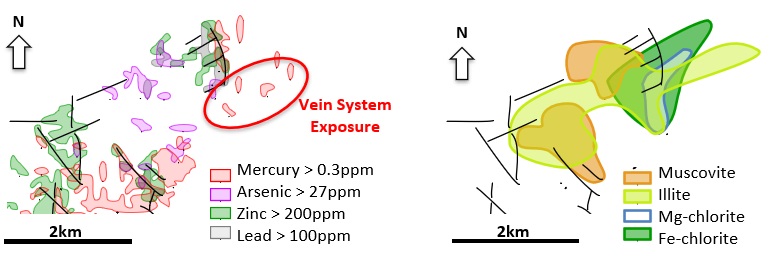

Solaris Resources (TSX:SLS)(NYSEAmerican:SLSR) has released an update on its exploration efforts at the Celestina target area, which is part of its broader district exploration program. The Celestina area is located east of the Warintza porphyry cluster and has become a focal point for the company’s search for epithermal deposits. The area is defined by a 4.5-kilometer by 3-kilometer zone of hydrothermal alteration, along with elevated levels of zinc, lead, arsenic, and mercury found in soil samples. These elements are typical indicators of potential mineralization, particularly in epithermal systems.
Highlight from the release are as follows:
- Follow-up rock chip sampling has returned high values of 16,019 g/t silver and 25.3 g/t gold, with other samples supporting the presence of an underlying silver-gold-base metals vein system
- Three parallel vein exposures were identified in creek beds within 100m on either side of the original breccia outcrop (link to release), located in a soft and chemically reactive mudstone unit that may have acted as a caprock to the hydrothermal system
- The conceptual exploration target at Celestina therefore lies in the underlying volcanic rocks that had full exposure to the hydrothermal cell while also having the properties to support robust vein and fracture formation
- Ongoing fieldwork to better define site selection for initial reconnaissance drilling
Recently, further prospecting outside of the previously identified anomalies led to the discovery of three parallel vein exposures in creek beds. These veins are located within 100 meters of the original breccia outcrop, which was reported in a press release on June 25, 2024. Follow-up sampling from these newly identified veins has returned significant results, including rock chip samples yielding up to 16,019 grams per ton (g/t) of silver and 25.3 g/t of gold. These findings have strengthened the company’s belief that there is an underlying silver-gold-base metals vein system at Celestina.
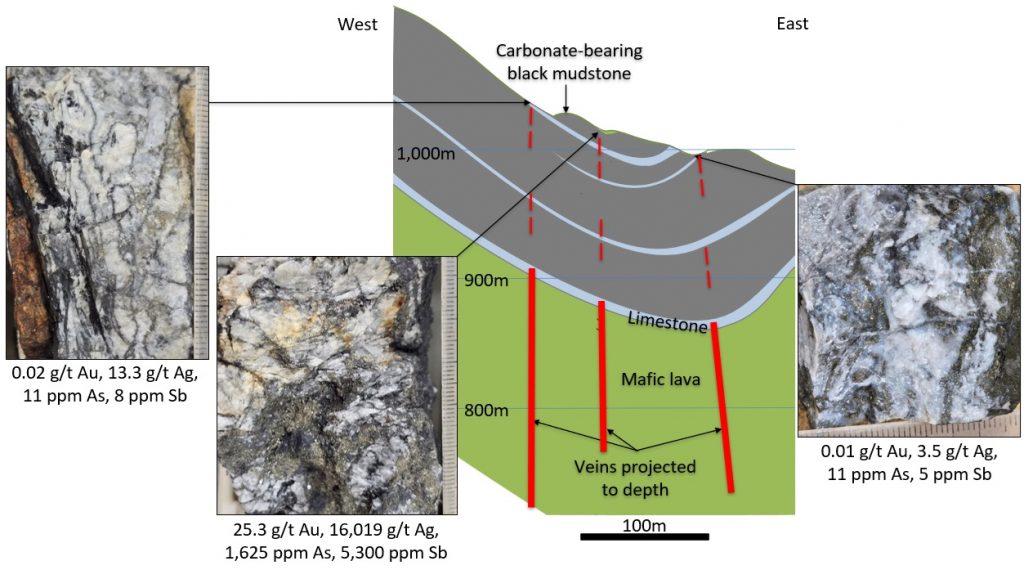

The veins identified so far have been found within a soft, chemically reactive mudstone unit. This mudstone may have acted as a caprock, potentially trapping hydrothermal fluids beneath it. As a result, the primary exploration target at Celestina is now believed to lie in the underlying volcanic rocks. These rocks would have been fully exposed to the hydrothermal system, making them more likely to host robust vein and fracture formations that could contain valuable mineralization.
Fieldwork at Celestina is ongoing, with efforts focused on locating additional vein exposures. By expanding the area covered, the team hopes to define the full extent of the vein system. More detailed mapping, sampling, and alteration studies are currently underway, aiming to better understand the zonation of the mineralization. In addition, geotechnical drilling is set to take place this month, with the goal of confirming the stratigraphic sequence of the area. These steps are essential for determining vectors that will guide the selection of sites for initial reconnaissance drilling, which will be crucial to confirming the presence of economically viable mineralization.
Solaris’ district exploration activities extend beyond Celestina. In the Caya-Mateo target area, geotechnical drilling has recently encountered evidence of epithermal clay alteration beneath overburden in a sandstone unit. This alteration is considered significant, as it indicates that hydrothermal activity occurred in the area. Drilling in the nearby Mateo area has also uncovered high-temperature alteration in volcanic rocks, further suggesting the presence of an epithermal system. The company plans to conduct additional mapping and sampling in the Mateo area, extending coverage toward the southeast where the core of the system is believed to lie.
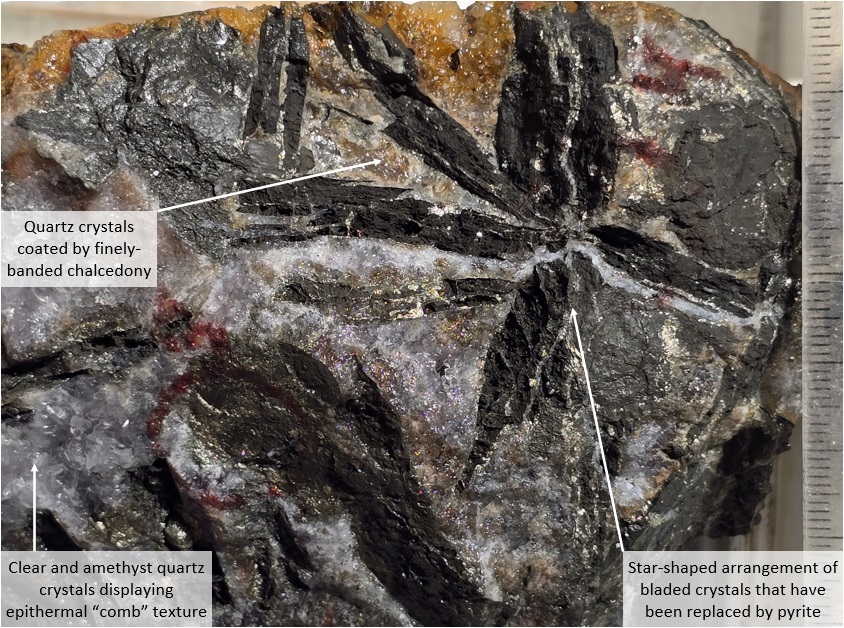

While the results at Celestina are still in the early stages, they have provided positive indications that the area could host a significant mineral system. The discovery of multiple veins with high gold and silver content underscores the potential of the Celestina target, although much more work remains to be done to fully assess the area’s mineral potential. As exploration continues, Solaris will look to refine its understanding of the geological controls on mineralization and pinpoint the best locations for future drilling. If successful, these efforts could add value to the company’s broader Warintza Project, which remains its flagship asset.
The above references an opinion and is for information purposes only. It is not intended to be investment advice. Seek a licensed professional for investment advice. The author is not an insider or shareholder of any of the companies mentioned above.
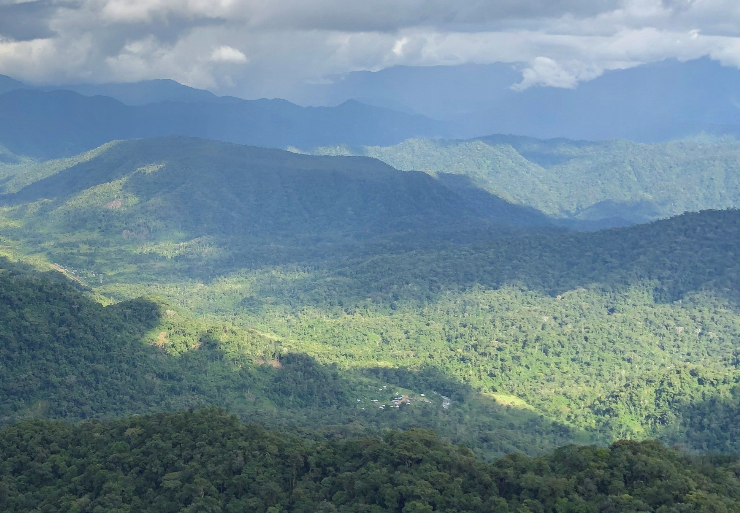

Solaris Resources (TSX:SLS) (NYSEAmerican:SLSR) has submitted an Environmental Impact Assessment (EIA) to Ecuador’s Ministry of Environment, Water, and Ecological Transition (MAATE) as part of its ongoing efforts to develop the Warintza Project in southeastern Ecuador. The EIA, comprising over 3,000 pages, reflects more than three and a half years of work, including community dialogue, environmental monitoring, and data collection. Solaris followed Ecuadorian regulations, and international best practices, and adhered to the Equator Principles framework and Performance Standards on Environmental and Social Sustainability from the International Finance Corporation.
This assessment is not Solaris’ first step in the permitting process for Warintza. The company had previously completed community consultations and submitted another EIA, which resulted in the granting of an environmental license in 2023. This enabled Solaris to advance exploration and develop infrastructure on the project site. Since then, the company has invested over $170 million in the project, with a substantial portion of procurement sourced locally. Currently, the project provides over 500 jobs, making it one of the most significant employers in the region.
Mr. Antonio Goncalves, Minister of Energy and Mines, commented in a press release: “The steady progress of the Warintza Project is positive for Ecuador. The Project is advancing in compliance with all legal regulations and will soon generate thousands of jobs and major economic growth in the Province of Morona Santiago. The administration of President Daniel Noboa supports this type of mining Project – one that has the support of the communities in its direct area of influence and is designed to meet high social, environmental, and technical standards.”
Mr. Sixto Cóndor, Governor of Morona Santiago, also commented: “Warintza is a project that will bring great opportunities and impetus to the development of the province. Like the Mirador project, which I recently visited, and its positive impacts in Zamora-Chinchipe, Warintza will be an engine for growth in Morona Santiago, with more generation of local employment sources, revitalization of the economy, social benefits, support for entrepreneurship, businesses and local suppliers. With Warintza, we will have a better province, with greater wealth to be distributed and better opportunities. We are ready to move forward.”
Mr. Antonio Castillo, Mayor of Limón Indanza, commented: “The people of Limón Indanza have benefited and will continue to benefit significantly through the creation of local employment and opportunities for the canton’s suppliers with the Warintza Project. The communities of Warints and Yawi decided to sign an agreement with the Company, through the Strategic Alliance, for the advancement of the Project and, as a Municipality, we respect and support this decision to work together.”
Mr. Javier Toro, Chief Operating Officer of Solaris, also commented: “The submission of the EIA and commencement of permitting for construction is a major milestone for the Warintza Project. We are very grateful to all our supporters, and in particular to our host communities and the Advisory Board of the Strategic Alliance of the Warintza Project who have been integral to the socialization of this EIA, the Mayor of Limón Indanza, the Governor of the Province of Morona Santiago, and the diligent professionals at MAATE.”
ESSAM Cía. Ltda., a well-regarded environmental consulting firm in Ecuador, prepared the EIA for Warintza. The firm has previously worked on other major mining projects in the country, such as the Mirador copper mine and the Fruta del Norte gold mine. ESSAM collaborated with international experts, including Knight Piésold Consulting, which provided expertise in areas such as waste management and water design, and Ausenco, which contributed to metallurgical studies and plant design.
With the submission of the EIA, Solaris is preparing to draw on the second tranche of a $15 million credit facility. This funding comes as part of an Offtake Credit Facility that the company had previously announced. Solaris currently has $84 million in available liquidity. The company expects to receive the next update on the project’s permitting process when the technical approval of the EIA is anticipated in the first half of 2025.
In addition to progressing the Warintza Project, Solaris has begun taking steps to move some of its operations to Ecuador. The company plans to transition its head office to Quito, Ecuador’s capital, where some of its senior management will be based. Solaris is evaluating further steps toward aligning its operations with local stakeholders and regulators as the project moves into its permitting phase. The company has indicated that this move is not expected to cause any adverse tax impacts or require changes to its stock exchange listings.
The Warintza Project, which has seen significant investment and progress, represents one of the few large-scale mining operations in Ecuador. It is important to the local economy, providing formal employment opportunities in a region with few alternatives. The submission of the EIA marks a major milestone for Solaris, with the company now awaiting government approvals to advance the project further.
The above references an opinion and is for information purposes only. It is not intended to be investment advice. Seek a licensed professional for investment advice. The author is not an insider or shareholder of any of the companies mentioned above.


Solaris Resources (TSX:SLS)(NYSEAmerican:SLSR) has released new drill results from its ongoing 60,000-meter, eight-rig drilling program at the Warintza Project in southeastern Ecuador. The company’s recent efforts have extended near-surface, high-grade mineralization in several directions, notably to the north, northwest, and southeast of the existing Mineral Resource Estimate (MRE).
The ongoing drilling campaign primarily focuses on open lateral extensions of mineralization. Infill drilling is also being carried out to upgrade mineral resources and convert areas previously considered waste. The main open vectors for expansion are to the northwest, southwest, and southeast.
A series of drill holes from a step-out platform have shown significant extensions of mineralization to the northwest, revealing high-grade deposits near the surface. This mineralization trend intersects a tabular granodiorite unit, which both separates and underlies the Central deposit from Warintza West. The area to the northwest also includes a large, undrilled molybdenum soil anomaly.
Key drill results from this region include:
- SLS-86 (drilled southwest) returned 57 meters of 1.11% Copper Equivalent (CuEq) within 105 meters of 0.88% CuEq from near surface.
- SLS-84 (drilled west) showed 69 meters of 0.82% CuEq within 102 meters of 0.64% CuEq from near surface.
- SLS-82 (drilled east) recorded 69 meters of 0.77% CuEq within 249 meters of 0.38% CuEq from surface.
In response to these findings, Solaris has constructed additional step-out platforms to further explore the potential of this anomaly and its connection to the Warintza West and Central deposits. Drilling is currently ongoing from the first platform, positioned approximately 1.3 kilometers northwest of SLS-86. Similar efforts are being made with platforms to the southwest, which are expected to contribute to a potential major expansion of the MRE, significantly enlarging the pit.
In addition to the northwest exploration, extensional drilling on the northern edge of the MRE has successfully extended mineralization further north. Infill drilling within this area has also been productive, with hole SLS-83 converting previously undefined waste within the pit.
Significant drill results from this northern region include:
- SLS-87 (drilled northwest) recorded 33 meters of 0.81% CuEq within 114 meters of 0.38% CuEq from surface.
- SLS-81 (drilled northeast) returned 165 meters of 0.54% CuEq within 327 meters of 0.33% CuEq from surface.
- SLS-80 (drilled east) showed 191 meters of 0.43% CuEq from near surface.
Further south, extensional drilling in the southeast sector of the project has extended mineralization, with potential for further exploration up to 600 meters within a large 0.8km x 0.8km undrilled molybdenum soil anomaly. Notably, hole SLSE-42 returned 300 meters of 0.57% CuEq within 359 meters of 0.53% CuEq from surface, reinforcing the growth potential in this area.
At Warintza East, located to the northeast, additional drilling has encountered lower-grade mineralization in several holes (SLSE-37 to SLSE-43). These results, however, are still important as they serve to convert previously undefined waste within the MRE pit shell. Further drilling is planned in this direction and to the east to better delineate the resource.
Meanwhile, Solaris continues complementary district exploration efforts. Geotechnical drilling in the Caya-Mateo target area has encountered epithermal clay alteration in sandstone and high-temperature alteration in the underlying volcanic rocks. This information is expected to assist in refining future exploration targets in the area. Additionally, fieldwork in the Celestina epithermal gold/silver area is ongoing, with the company anticipating the release of the next batch of results soon.
Table 1 – Assay Results
| Hole ID | Date Reported | From (m) | To (m) | Interval (m) | Cu (%) | Mo (%) | Au (g/t) | CuEq² (%) |
| SLS-87 | Aug 15, 2024 | 0 | 114 | 114 | 0.23 | 0.02 | 0.05 | 0.38 |
| Including | 81 | 114 | 33 | 0.64 | 0.02 | 0.06 | 0.81 | |
| SLS-86 | 54 | 159 | 105 | 0.58 | 0.04 | 0.11 | 0.88 | |
| Including | 60 | 117 | 57 | 0.77 | 0.05 | 0.13 | 1.11 | |
| SLS-85 | 0 | 123 | 123 | 0.12 | 0.02 | 0.04 | 0.23 | |
| Including | 102 | 123 | 21 | 0.41 | 0.01 | 0.03 | 0.51 | |
| SLS-84 | 54 | 156 | 102 | 0.38 | 0.04 | 0.07 | 0.64 | |
| Including | 54 | 123 | 69 | 0.52 | 0.04 | 0.10 | 0.82 | |
| SLS-83 | 15 | 265 | 250 | 0.15 | 0.00 | 0.14 | 0.25 | |
| SLS-82 | 0 | 249 | 249 | 0.17 | 0.03 | 0.04 | 0.38 | |
| Including | 48 | 117 | 69 | 0.47 | 0.04 | 0.12 | 0.77 | |
| SLS-81 | 0 | 327 | 327 | 0.20 | 0.02 | 0.04 | 0.33 | |
| Including | 84 | 249 | 165 | 0.35 | 0.03 | 0.04 | 0.54 | |
| SLS-80 | 69 | 260 | 191 | 0.34 | 0.01 | 0.04 | 0.43 | |
| SLSE-43 | 0 | 295 | 295 | 0.13 | 0.01 | 0.02 | 0.18 | |
| SLSE-42 | 0 | 359 | 359 | 0.38 | 0.02 | 0.06 | 0.53 | |
| Including | 21 | 321 | 300 | 0.42 | 0.02 | 0.06 | 0.57 | |
| SLSE-41 | 0 | 258 | 258 | 0.07 | 0.00 | 0.02 | 0.09 | |
| SLSE-40 | 6 | 39 | 33 | 0.13 | 0.00 | 0.02 | 0.16 | |
| SLSE-39 | 60 | 318 | 258 | 0.19 | 0.01 | 0.04 | 0.26 | |
| Including | 60 | 102 | 42 | 0.30 | 0.01 | 0.04 | 0.38 | |
| SLSE-38 | 93 | 152 | 59 | 0.19 | 0.00 | 0.03 | 0.23 | |
| Including | 108 | 132 | 24 | 0.26 | 0.00 | 0.05 | 0.31 | |
| SLSE-37 | 153 | 258 | 105 | 0.12 | 0.02 | 0.02 | 0.23 | |
| Including | 360 | 419 | 59 | 0.11 | 0.02 | 0.01 | 0.21 |
Notes to Table 1: True widths are interpreted to be very close to drilled widths due to the bulk-porphyry style mineralized zones at Warintza.
Table 2 – Collar Locations
| Hole ID | Easting | Northing | Elevation (m) |
Depth (m) |
Azimuth (degrees) | Dip (degrees) |
| SLS-87 | 800198 | 9648473 | 1338 | 295 | 315 | -60 |
| SLS-86 | 799685 | 9648332 | 1374 | 251 | 250 | -50 |
| SLS-85 | 800199 | 9648475 | 1336 | 274 | 0 | -60 |
| SLS-84 | 799684 | 9648330 | 1374 | 200 | 270 | -69 |
| SLS-83 | 800621 | 9648398 | 1332 | 265 | 120 | -58 |
| SLS-82 | 799682 | 9648329 | 1373 | 302 | 90 | -85 |
| SLS-81 | 800198 | 9648471 | 1339 | 400 | 65 | -52 |
| SLS-80 | 800200 | 9648473 | 1338 | 260 | 90 | -77 |
| SLSE-43 | 801615 | 9648467 | 1104 | 296 | 210 | -60 |
| SLSE-42 | 801528 | 9647849 | 1154 | 360 | 170 | -70 |
| SLSE-41 | 801612 | 9648466 | 1105 | 259 | 120 | -50 |
| SLSE-40 | 801616 | 9648469 | 1104 | 141 | 90 | -75 |
| SLSE-39 | 801385 | 9648268 | 1244 | 318 | 270 | -67 |
| SLSE-38 | 801615 | 9648469 | 1104 | 152 | 0 | -90 |
| SLSE-37 | 801388 | 9648263 | 1243 | 419 | 30 | -80 |
Notes to table: The coordinates are in WGS84 17S Datum.
Endnotes
- Refer to press release dated July 22, 2024. NI 43-101 Technical Report to be released within 45 days of the July 22, 2024 news release and available on the Company’s website and Sedar+.
- Copper-equivalence grade calculation for reporting assumes metal prices of US$4.00/lb Cu, US$20.00/lb Mo, and US$1,850/oz Au, and recoveries of 90% Cu, 85% Mo, and 70% Au based on preliminary metallurgical testwork. CuEq formula: CuEq (%) = Cu (%) + 5.604 × Mo (%) + 0.623 × Au (g/t).
The above references an opinion and is for information purposes only. It is not intended to be investment advice. Seek a licensed professional for investment advice. The author is not an insider or shareholder of any of the companies mentioned above.


Solaris Resources (TSX:SLS) (NYSEAmerican:SLSR) has successfully completed joint socialization programs with government entities and local communities to support the initial exploration activities of its district exploration programs at the Warintza Project in southeastern Ecuador. This initiative marks a major step in Solaris’s efforts to advance its exploration projects in the region.
These socialization programs aim to create understanding and support for the company’s initial exploration activities. Members of local communities, as well as representatives from canton and provincial governments and key ministries of the national government, attended the sessions. Solaris presented its proposed exploration activities, emphasizing commitments to local hiring and contracting, education, technical training, capacity building, and community relations and environmental management programs.
The success of these socialization programs provides a template for Solaris’s broader ambitions in the northern Zamora belt. The company intends to secure a joint venture partner to further its exploration efforts in this area.
Mr. René Cuesta, delegate of the Ministry of Energy and Mines, commented in a press release: “These types of meetings show us that it is possible to do mineral exploration in a united way: society, community, company and government. I congratulate the Company and communities because communicating ratifies work in mutual harmony without discrepancies. This shows that the Company works for the development of the communities, and for the good of Limón Indanza canton, Morona Santiago province and Ecuador.”
Mr. Cristian León, delegate of the Ministry of the Environment stated: “We see that the process of socialization has been carried out with total transparency, complying with the previous processes of call and information. It is gratifying to see that the community, cantonal and provincial authorities all participated enthusiastically in this socialization. This is a demonstration of responsibility and commitment on all sides.”
Mr. Jorge Valverde, Political Head of the Limón Indanza canton, also commented in the release: “Socialization with the communities is very important since all the work that will be carried out by the Company is informed by their input. The communities have to understand what the processes are, the way of working and how the hiring will be carried out. I am representing the Governor, and I am very satisfied to see that people are accepting this information provided by the Company.”
Mr. Federico Velásquez, President Latin America of Solaris added: “Engaging with local communities ensures their concerns are central to our planning and enhances the benefits of our activities. Our exploration creates economic opportunities, supports local businesses, and advances community development. This approach aligns with community values, promotes sustainable growth, and demonstrates our commitment to responsible mining.”


Following the successful socialization programs, geotechnical drilling has commenced at the Caya-Mateo target. This drilling is expected to provide important geological information to aid in more focused targeting efforts and subsequent discovery drilling. Meanwhile, fieldwork continues in the Celestina epithermal gold/silver area, where prior sampling returned significant values of up to 11,570 grams per tonne (g/t) of silver and 12.3 g/t of gold across a 30cm breccia outcrop. The next batch of results from this fieldwork is expected soon.
In addition to this, Solaris Resources recently reported an In-Pit Mineral Resources Estimate (MRE) for the Warintza Project on July 22, 2024. The ongoing mineral resource drilling includes over 30,000 meters in the second half of 2024, targeting open extensions and upgrading mineral resources to support a Pre-Feasibility Study (PFS) scheduled for the second half of 2025. Concurrent district exploration programs aim to discover complementary deposits from an expanded portfolio of epithermal gold/silver and porphyry copper targets.
The above references an opinion and is for information purposes only. It is not intended to be investment advice. Seek a licensed professional for investment advice. The author is not an insider or shareholder of any of the companies mentioned above.
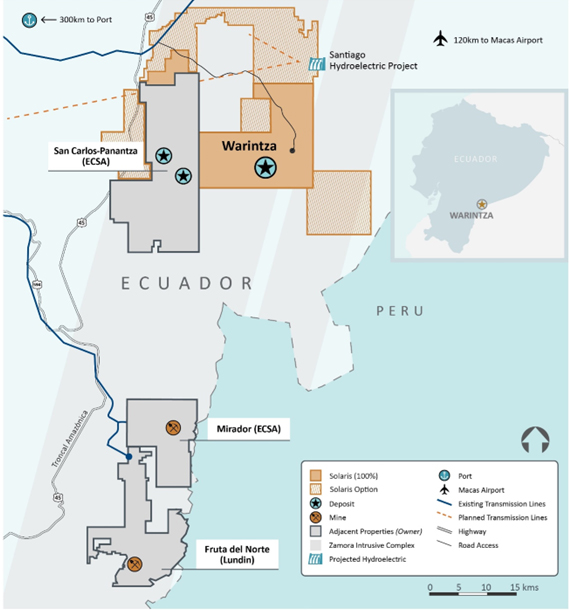

Solaris Resources (TSX:SLS)(NYSEAmerican:SLSR) has announced an In-Pit Mineral Resources Estimate (MRE) for its Warintza Project in southeastern Ecuador. The ongoing mineral resource drilling encompasses over 30,000 meters in the second half of 2024, targeting open extensions and upgrading mineral resources to support the Pre-Feasibility Study (PFS) set for the second half of 2025. Concurrent district exploration programs are also targeting complementary discoveries from an expanded portfolio of epithermal gold/silver and porphyry copper targets.
Mr. Javier Toro, Chief Operating Officer, commented in a press release: “We are very pleased to be able to release this standalone MRE which draws on our combined years of experience with open pit copper projects in the Americas. This new MRE provides a solid foundation for future updates and a robust mine plan with a low strip ratio, simple metallurgy and clean concentrates. In support of the PFS, we are doing further technical, infill and extensional drilling into open areas within and adjacent to the pit shell.”
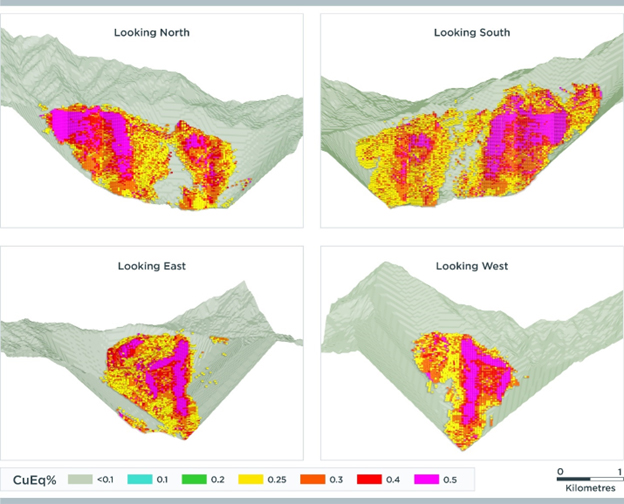

The In-Pit Mineral Resources at Warintza include 232 million tonnes (Mt) at 0.64% copper equivalent (CuEq) in the measured category and 677 Mt at 0.49% CuEq in the indicated category, resulting in a total of 909 Mt at 0.53% CuEq in measured and indicated categories. An additional 1,426 Mt at 0.37% CuEq is inferred at a base case cut-off grade of 0.25% CuEq. At a higher cut-off grade of 0.50% CuEq, the resources include 157 Mt at 0.76% CuEq in the measured category and 269 Mt at 0.69% CuEq in the indicated category, totaling 427 Mt at 0.71% CuEq in measured and indicated categories, with an additional 177 Mt at 0.62% CuEq in the inferred category.
Warintza is strategically located at a low elevation within the southeast Ecuador mining district. The site benefits from a direct highway connection to Pacific ports and access to low-cost hydroelectric grid power, with potential further development at the adjoining Santiago G8 project. The region has seen significant socioeconomic improvement from mining exploration and development over the past decade.
The 2024 drilling program involves 60,000 meters, with over 30,000 meters planned for the second half of the year. This drilling will be conducted from 140 holes on 80 platforms to provide improved coverage, targeting open lateral extensions, upgrading mineral resources, and converting remaining uncategorized blocks within the pit shell to support the PFS in 2025. Additionally, metallurgical, geotechnical, and hydrogeological drilling is ongoing.
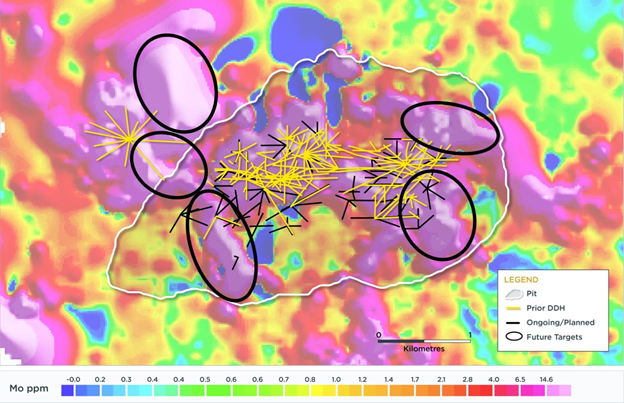

Complementary district exploration efforts are also underway. Fieldwork is targeting epithermal-style gold-silver mineralization south of Caya-Mateo, where recent sampling has returned values between 4 and 12 grams per tonne (g/t) of gold. Field crews are also focused on mapping and sampling combined geophysical and geochemical porphyry copper targets.
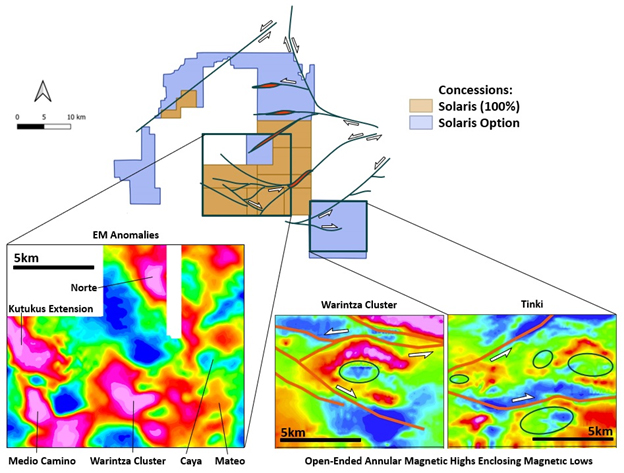

Highlights from the results are as follows:
Table 1: Warintza Mineral Resource Estimate Sensitivity
| Cut-off | Category | Tonnage | Grade | |||
| CuEq (%) | (Mt) | CuEq (%) | Cu (%) | Mo (%) | Au (g/t) | |
| 0.15% | Measured | 246 | 0.61 | 0.45 | 0.02 | 0.05 |
| Indicated | 836 | 0.44 | 0.30 | 0.02 | 0.04 | |
| M&I | 1,082 | 0.48 | 0.34 | 0.02 | 0.04 | |
| Inferred | 3,135 | 0.27 | 0.20 | 0.01 | 0.04 | |
| 0.25% (Base Case) |
Measured | 232 | 0.64 | 0.47 | 0.02 | 0.05 |
| Indicated | 677 | 0.49 | 0.34 | 0.02 | 0.04 | |
| M&I | 909 | 0.53 | 0.37 | 0.02 | 0.05 | |
| Inferred | 1,426 | 0.37 | 0.27 | 0.01 | 0.04 | |
| 0.35% | Measured | 207 | 0.68 | 0.50 | 0.03 | 0.06 |
| Indicated | 497 | 0.56 | 0.40 | 0.02 | 0.05 | |
| M&I | 704 | 0.60 | 0.43 | 0.02 | 0.05 | |
| Inferred | 640 | 0.47 | 0.34 | 0.02 | 0.05 | |
| 0.50% (Higher Grade) |
Measured | 157 | 0.76 | 0.56 | 0.03 | 0.06 |
| Indicated | 269 | 0.69 | 0.50 | 0.03 | 0.05 | |
| M&I | 427 | 0.71 | 0.52 | 0.03 | 0.06 | |
| Inferred | 177 | 0.62 | 0.45 | 0.02 | 0.07 | |
Notes to Table 1:
- The Mineral Resource Estimate was prepared in accordance with the Canadian Institute of Mining, Metallurgy and Petroleum (“CIM”) Definition Standards for Mineral Resources and Mineral Reserves, adopted by the CIM Council on May 10, 2014.
- Reasonable prospects for eventual economic extraction assume open-pit mining with conventional flotation processing and were tested using Whittle and Minesight pit optimization software with the following assumptions: metal prices of US$4.00/lb Cu, US$20.00/lb Mo, and US$1,850/oz Au; operating costs of US$1.50/t+US$0.02/t per bench mining, US$5.0/t milling, US$1.0/t G&A, and recoveries of 90% Cu, 85% Mo, and 70% Au based on preliminary metallurgical testwork.
- Metal price assumptions for copper, molybdenum and gold are based on a discount to the lesser of the 3-year trailing average (in accordance with US Securities and Exchange Commission guidance) and current spot prices for each metal.
- Mineral Resources include grade capping and dilution. Grade was interpolated by ordinary kriging populating a block model with block dimensions of 25m x 25m x 15m.
- Mineral Resources that are not Mineral Reserves do not have demonstrated economic viability.
- Copper-equivalent grade calculation for reporting assumes metal prices of US$4.00/lb Cu, US$20.00/lb Mo, and US$1,850/oz Au, and recoveries of 90% Cu, 85% Mo, and 70% Au based on preliminary metallurgical testwork and includes provisions for downstream selling costs. CuEq formula: CuEq (%) = Cu (%) + 5.604 × Mo (%) + 0.623 × Au (g/t).
- The Mineral Resources estimate was prepared by Mario E. Rossi, FAusIMM, RM-SME, Principal Geostatistician of Geosystems International Inc., who is an Independent Qualified Person under NI 43-101. The Mineral Resources estimate is at a base case of 0.25% CuEq¹ cut-off grade and other estimates at varying cut-off grades are included only to demonstrate the sensitivity of the Mineral Resources estimate and are not the QP’s estimate of the Mineral Resources for the property.
- In Mr. Rossi’s opinion, there are currently no relevant factors or legal, political, environmental, or other risks that could materially affect the potential development of Mineral Resources.
- All figures are rounded to reflect the relative accuracy of the estimate and therefore may not appear to add precisely.
- The effective date of the mineral resource estimate is July 1, 2024.
Endnotes
- Copper-equivalence grade calculation for reporting assumes metal prices of US$4.00/lb Cu, US$20.00/lb Mo, and US$1,850/oz Au, and recoveries of 90% Cu, 85% Mo, and 70% Au based on preliminary metallurgical testwork and includes provisions for downstream selling costs. CuEq formula: CuEq (%) = Cu (%) + 5.604 × Mo (%) + 0.623 × Au (g/t).
The above references an opinion and is for information purposes only. It is not intended to be investment advice. Seek a licensed professional for investment advice. The author is not an insider or shareholder of any of the companies mentioned above.


Solaris Resources Inc. (TSX: SLS)(NYSEAmerican:SLSR) recently reported drill results from its ongoing 2024 drilling program at the Warintza Project in southeastern Ecuador. The latest findings include the final assays for the upcoming updated mineral resource estimate, anticipated later this month.
- Drill hole SLSE-36, positioned at the southeasternmost platform at Warintza Southeast, revealed 148 meters of 0.72% copper equivalent (CuEq) within a larger interval of 325 meters of 0.51% CuEq from the surface. This hole remains open in strong mineralization, with the final 34 meters averaging 0.90% CuEq.
- SLS-77, located on the northern boundary of the Northeast Extension of Warintza Central, returned 108 meters of 0.70% CuEq from near the surface within a broader interval of 273 meters of 0.57% CuEq from the surface.
- SLS-78, drilled from a new platform 100 meters to the west, showed 78 meters of 0.70% CuEq within a larger interval of 114 meters of 0.65% CuEq from a depth of 72 meters before hitting low-grade granodiorite.
- SLS-79, drilled from the same platform at a steeper inclination, returned 78 meters of 0.60% CuEq from near the surface within a broader interval of 248 meters of 0.50% CuEq, ending in strong mineralization.
- SLST-03, drilled approximately 300 meters south of Warintza Central at the Trinche platform, aimed to convert undefined waste within the expected pit shell. This hole returned 312 meters of 0.62% CuEq within a larger interval of 1,028 meters of 0.30% CuEq from the surface.
- Patrimonio hole 04, consistent with holes 01 and 02, intersected a roughly 150-meter thick tabular zone of replacement mineralization dipping shallowly to the west. The source of this mineralization has not yet been found. SLSP-03, collared at a higher elevation, intersected a low-grade layer in the host lava sequence before passing into a barren, post-mineral porphyry that intruded and displaced the targeted mineralized layer. Mineral alteration zoning and geochemistry suggest that the core of the mineralized system lies to the south.
The 2024 drill program has recently expanded to 60,000 meters, comprising 140 holes from 80 platforms, providing significantly improved drilling coverage. By the end of June, 27,000 meters in 74 holes were completed. Seven rigs are targeting over 8 kilometers of drilling in July, facilitated by improved site logistics from infrastructure development.
Current drilling focuses on Patrimonio exploration, resource extension at Warintza Southeast, and infill and technical drilling to support the Prefeasibility Study (PFS) in the second half of 2025. This includes geotechnical holes that are expected to provide insights into the geology of the Caya-Mateo epithermal gold and silver target area.
Solaris Resources’ continued efforts at the Warintza Project underscore its commitment to expanding and defining the mineral resources within this promising area. The anticipated updated mineral resource estimate will likely provide further clarity on the potential and future development of the Warintza Project.
Other results include:
Table 1 – Assay Results
| Hole ID | Date Reported | From (m) | To (m) | Interval (m) | Cu (%) | Mo (%) | Au (g/t) | CuEq¹ (%) |
| SLS-79 | July 09, 2024 | 15 | 263 | 248 | 0.41 | 0.02 | 0.05 | 0.50 |
| Including | 54 | 132 | 78 | 0.52 | 0.01 | 0.05 | 0.60 | |
| SLS-78 | 72 | 186 | 114 | 0.54 | 0.02 | 0.07 | 0.65 | |
| Including | 93 | 171 | 78 | 0.58 | 0.02 | 0.08 | 0.70 | |
| SLS-77 | 0 | 273 | 273 | 0.43 | 0.02 | 0.10 | 0.57 | |
| Including | 21 | 129 | 108 | 0.56 | 0.02 | 0.10 | 0.70 | |
| SLSE-36 | 0 | 325 | 325 | 0.40 | 0.02 | 0.05 | 0.51 | |
| Including | 177 | 325 | 148 | 0.58 | 0.03 | 0.07 | 0.72 | |
| Including | 291 | 325 | 34 | 0.76 | 0.03 | 0.08 | 0.90 | |
| SLSP-04 | 30 | 204 | 174 | 0.25 | 0.02 | 0.06 | 0.35 | |
| Including | 104 | 152 | 48 | 0.30 | 0.02 | 0.08 | 0.43 | |
| SLSP-03 | 0 | 310 | 310 | 0.10 | 0.01 | 0.04 | 0.14 | |
| SLST-03 | 16 | 1044 | 1028 | 0.24 | 0.01 | 0.03 | 0.30 | |
| Including | 646 | 958 | 312 | 0.51 | 0.02 | 0.06 | 0.62 |
Notes to table: True widths are interpreted to be very close to drilled widths due to the bulk-porphyry style mineralized zones at Warintza.
Table 2 – Collar Locations
| Hole ID | Easting | Northing | Elevation (m) |
Depth (m) |
Azimuth (degrees) | Dip (degrees) |
| SLS-79 | 800197 | 9648470 | 1340 | 263 | 270 | -88 |
| SLS-78 | 800197 | 9648469 | 1340 | 220 | 270 | -65 |
| SLS-77 | 800439 | 9648493 | 1271 | 324 | 320 | -85 |
| SLSE-36 | 801529 | 9647848 | 1154 | 325 | 220 | -85 |
| SLSP-04 | 799364 | 9647811 | 1526 | 309 | 145 | -60 |
| SLSP-03 | 799349 | 9647450 | 1627 | 310 | 40 | -65 |
| SLST-03 | 800192 | 9647550 | 1592 | 1123 | 330 | -50 |
Notes to table: The coordinates are in WGS84 17S Datum.
Endnotes
- Copper-equivalence calculated as: CuEq (%) = Cu (%) + 4.0476 × Mo (%) + 0.487 × Au (g/t), utilizing metal prices of US$3.50/lb Cu, US$15.00/lb Mo, and US$1,500/oz Au, and assumes recoveries of 90% Cu, 85% Mo, and 70% Au based on preliminary metallurgical test work.
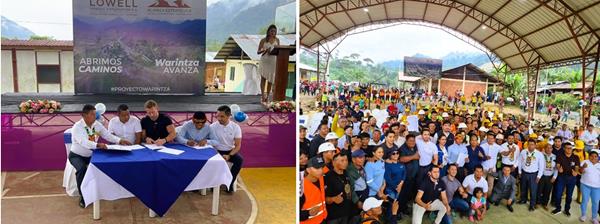


Solaris Resources (TSX:SLS)(NYSEAmerican:SLSR) has issued a statement to address false and misleading claims made by anti-mining NGOs regarding the social license of its Warintza Project in southeastern Ecuador. The company emphasizes that the Warintza Project resides on the ancestral lands of the Warints and Yawi communities, which have been officially registered and defined by the Ecuadorian government since 2002. These communities are the sole legal entities with rights and authority over these lands.
The International Labor Organization has recognized the Warints and Yawi as the sole titleholders of their ancestral lands. It has also acknowledged the legality of the Strategic Alliance, a governance structure created by Solaris to ensure community consent for the Warintza Project. This Alliance is managed by an Advisory Board of Directors comprising company representatives and democratically elected members from each community.
The Ecuadorian Ministry of Environment has conducted two consultation processes, confirming that the Warints and Yawi communities are directly influenced by the Warintza Project. These consultations have successfully facilitated the project’s progression from initial exploration to advanced exploration, following an Environmental Impact Assessment and the issuance of an Environmental License.
Solaris has obtained explicit consent for the project from the Warints and Yawi through formal community agreements. These agreements include an Impact and Benefits Agreement signed in 2020 and subsequently updated in 2022 and 2024 to reflect the project’s growth and commitment to its host communities. Notably, all surrounding communities contribute employees to the project, and many have expressed interest in partnering with Solaris regarding their own lands.
In March 2024, Solaris signed a trilateral cooperation agreement with the Interprovincial Federation of Shuar Centers (FICSH), the highest authority representing 143,000 Shuar indigenous people, and the Alliance for Entrepreneurship and Innovation of Ecuador. This agreement was signed in the presence of senior Ecuadorian government officials. Mr. David Tankamash, President of FICSH, commented at the time, “We support the Warints and Yawi communities and reject the efforts of foreign NGOs who act against the will and interest of our members.”
Solaris cautions shareholders and investors against the misinformation propagated by NGOs and other third parties. The company reiterates its commitment to transparency and encourages interested parties to seek accurate information directly from them.
Mr. Froilan Juank, President of the Yawi Shuar Center, commented: “We are the legitimate registered owners of the Ancestral Lands on which the Warintza Project resides and we have the right and have chosen, through our General Assembly, to participate in the Project through our Strategic Alliance and Impact and Benefits Agreement.”
Mr. Agustin Kayak, Trustee of the Warints Shuar Center, stated: “We and the Yawi community have decided to move forward with the Warintza Project. We are the owners of the lands where Warintza is located. We work together, the two communities of Warints and Yawi, for the well-being and development of our people.”
Mr. Emmanuel Delaune, Manager of Ecuadorean state-owned mining company, Empresa Nacional Minera, stated: “Solaris is an example to follow with its Warintza Model, which contributes to the local development of the Shuar communities through transparency, citizen participation, environmental stewardship and social development. These are the principles by which Solaris has earned the necessary credentials to operate in this area of Ecuador.”
The above references an opinion and is for information purposes only. It is not intended to be investment advice. Seek a licensed professional for investment advice. The author is not an insider or shareholder of any of the companies mentioned above.
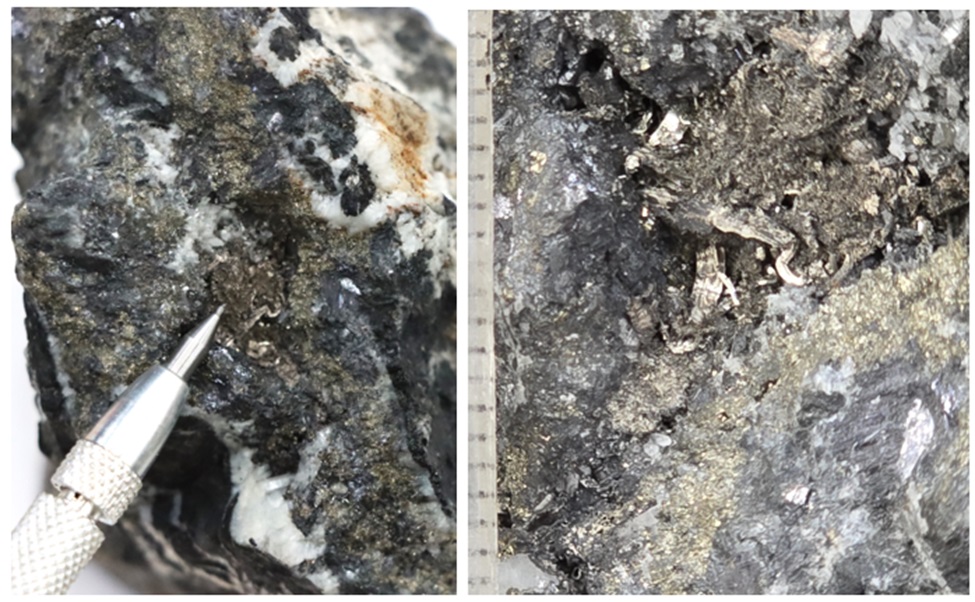

Solaris Resources (TSX:SLS) (NYSEAmerican:SLSR), has reported the discovery of significant precious metal deposits, which have substantially expanded the known area of epithermal-style mineral alteration. Initially concentrated in the Caya area, this mineralization has now been traced through the adjacent Mateo target and several kilometers further south. The expansion was identified through reconnaissance rock-chip sampling in the newly explored southern region. This sampling program yielded impressive results, with assays revealing up to 11,570 grams per tonne of silver (g/t Ag) and 12.3 grams per tonne of gold (g/t Au) across a 30-centimeter section of breccia outcrop.
These findings represent a major breakthrough in Solaris’ exploration activities at the Warintza Project. In response to these promising results, the company has intensified its fieldwork efforts to further delineate and refine potential drilling targets. Solaris anticipates commencing exploration drilling in this newly discovered area either towards the end of the third quarter or early in the fourth quarter of 2024.
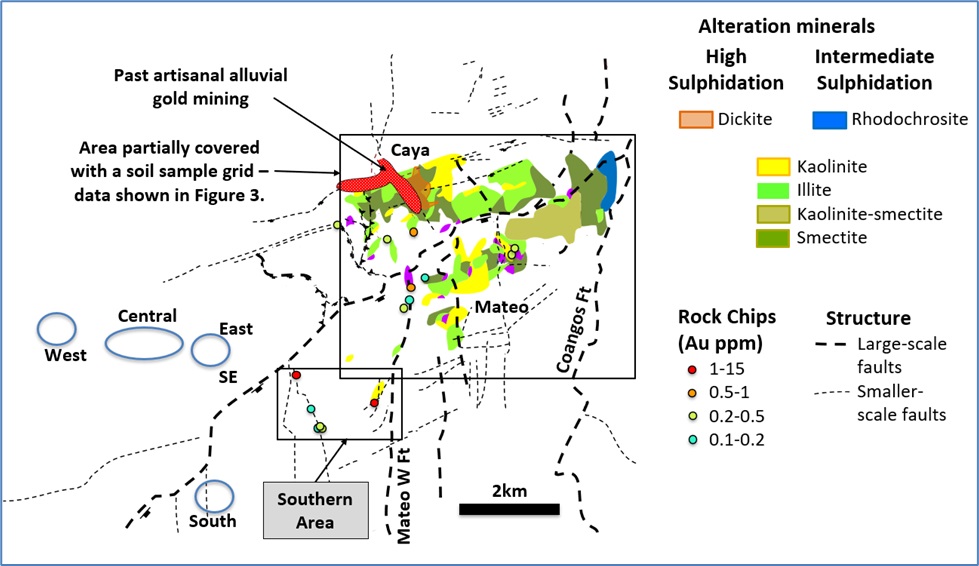

Highlights from the results are as follows:
- Ongoing regional exploration east of the Warintza cluster has expanded the area of interest for epithermal mineralization from the Caya-Mateo area several kilometres to the south (Figure 2)
- Epithermal deposits can be genetically related to porphyry systems and host rich concentrations of gold and silver, with this association well documented in southeastern Ecuador
- The newly-sampled southern area is affected by minor fault splays off a major regional fault thought to be of Jurassic age, with kilometer-scale displacement across it
- This fault separates intrusive-dominated geology to the west hosting the Warintza porphyry cluster from primarily volcanic-sedimentary geology to the east hosting epithermal mineralization
- The footwall (western side) of this fault forms the margin of an adjacent north-south pull-apart basin filled with volcanic-sedimentary sequences
- Initial reconnaissance rock-chip sampling in this area has returned values of up to 11,570 g/t Ag and 12.3 g/t Au across 30cm of breccia outcrop with exceptionally high concentrations of epithermal pathfinder elements (Figure 1)
- In addition to the above, sporadic high gold values of between 4 g/t and 9 g/t, with silver values up to 150 g/t, in rock chip sampling have also been returned, with anomalous pathfinder values consistently occurring over an area 1km by 2km
- The working exploration concept is that these samples represent high-level expressions of an intermediate sulphidation epithermal system at depth
- Detailed mapping and sampling of this area has commenced, with vectors from geochemical data and mineral alteration to be used to refine targets
- Separately, recent sampling and spectral mapping in the Caya-Mateo target area have outlined pathfinder element and alteration anomalies at the margins of overlying sandstones (Figure 3)
- Mateo requires follow-up programs to extend coverage southeast over this large target area and establish metal and alteration zonation to define its core
- A series of geotechnical holes previously planned in Caya-Mateo to support Pre-Feasibility technical studies near the epithermal target area, are expected to commence in July and are expected to provide valuable exploration data
- Initial exploration drilling at Caya, Mateo and the new southern area will be planned on the basis of the ongoing exploration work and scheduled for late Q3/24 – early Q4/24
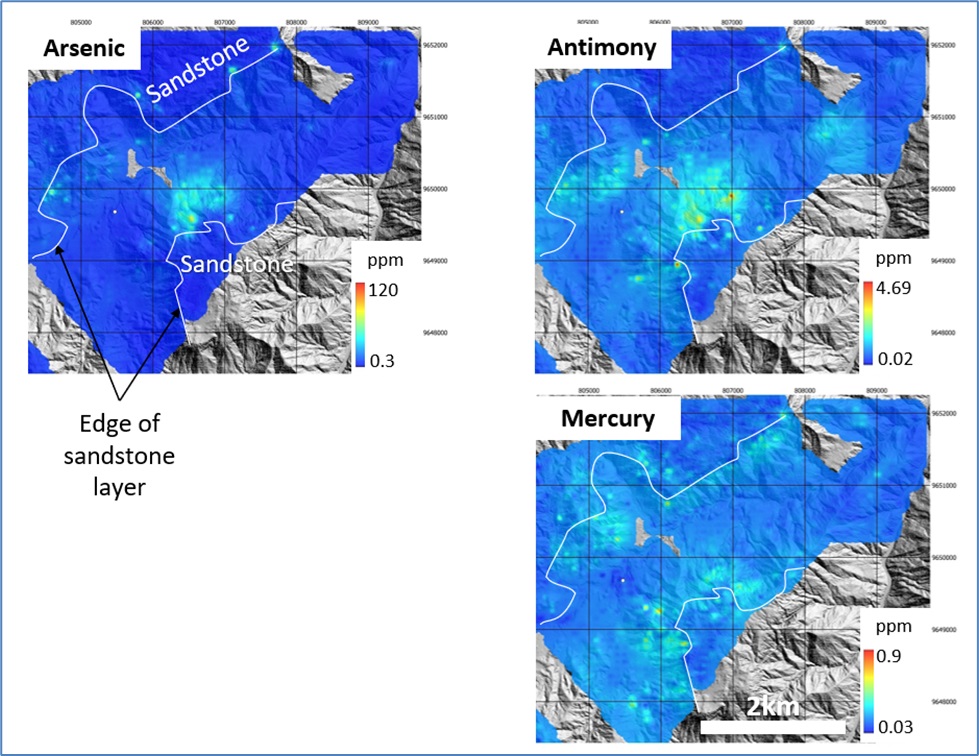

The above references an opinion and is for information purposes only. It is not intended to be investment advice. Seek a licensed professional for investment advice. The author is not an insider or shareholder of any of the companies mentioned above.


Solaris Resources Inc. (TSX:SLS)(NYSEAmerican:SLSR) has announced an expansion of its 2024 drilling program at the Warintza Project in southeastern Ecuador, doubling the planned meterage from 30km to 60km. The expansion is supported by the company’s recent financing and significant productivity improvements resulting from past infrastructure investments, improved logistics, and optimized processes at the project site.
Mr. Javier Toro, Chief Operating Officer, commented in a press release: “We are very pleased to have doubled the planned drilling for the Warintza project which will contribute to future growth and improved confidence in resources while also providing technical data for mine design and mine planning purposes to support technical studies. The forthcoming mineral resource estimate update in July will reflect two years of additional drilling from the prior estimate in 2022, with drilling continuing through the end of the year.”
The company has reported additional drill results as its 2024 drilling program ramps up. Drill hole SLSE-33, collared on the southern margin of Warintza Southeast and drilled at a steep inclination northeast, returned 81m of 0.73% CuEq¹ from near surface within a broader interval of 544m of 0.50% CuEq¹ from surface, bottoming in mineralization. SLSE-35, collared from a central platform at Warintza East and drilled east, returned 189m of 0.50% CuEq¹ from surface within a broader interval of 580m of 0.42% CuEq¹, remaining open in mineralization with the last 10m averaging 0.41% CuEq¹.
Solaris Resources has been able to ramp up drilling with six rigs completing 7.7 km in May, and a seventh rig is expected to be added soon. The company aims to challenge the prior peak drilling rate achieved with 12 rigs in 2021, primarily due to improved logistics from infrastructure investments, construction of on-site facilities, and trail networks connecting new drilling platform locations, along with process optimization.
The expanded drilling program will target open lateral extensions of mineralization beyond the pit, including into the Patrimonio target area, improve drilling density, and support technical studies. The company is also on track to release an updated mineral resource estimate in early July.
Ongoing regional exploration efforts have expanded the footprint of epithermal-style mineral alteration from the Caya area into the adjacent Mateo porphyry target, located 6km east of the Warintza cluster. Field crews have also been active on the newly-acquired adjacent claims, with further details to be provided in subsequent releases.
To ensure the accuracy of the sample assay results, Solaris Resources Inc. has implemented a quality control/quality assurance (QA/QC) program that includes the insertion of blind certified reference materials (standards), blanks, and field duplicate samples. Logging and sampling are completed at a secured company facility located on site, with drill core being cut in half on site and samples securely transported to ALS Labs in Quito. Sample pulps are sent to ALS Labs in Lima, Peru, and Vancouver, Canada, for analysis, with selected pulp check samples sent to Bureau Veritas lab in Lima, Peru, for independent verification. Both ALS Labs and Bureau Veritas lab are independent of Solaris Resources Inc.
Table 1 – Assay Results
| Hole ID | Date Reported | From (m) |
To (m) |
Interval (m) |
Cu (%) |
Mo (%) |
Au (g/t) |
CuEq¹ (%) |
| SLSE-35 | June 11, 2024 | 0 | 580 | 580 | 0.33 | 0.02 | 0.04 | 0.42 |
| Including | 0 | 189 | 189 | 0.41 | 0.02 | 0.04 | 0.50 | |
| SLSE-34 | 0 | 522 | 522 | 0.28 | 0.02 | 0.03 | 0.36 | |
| Including | 66 | 318 | 252 | 0.31 | 0.02 | 0.03 | 0.40 | |
| SLSE-33 | 6 | 550 | 544 | 0.40 | 0.02 | 0.06 | 0.50 | |
| Including | 54 | 135 | 81 | 0.60 | 0.02 | 0.07 | 0.73 |
Notes to table: True widths are interpreted to be very close to drilled widths due to the bulk-porphyry style mineralized zones at Warintza.
Table 2 – Collar Locations
| Hole ID | Easting | Northing | Elevation (m) |
Depth (m) |
Azimuth (degrees) |
Dip (degrees) |
| SLSE-35 | 801485 | 9648192 | 1129 | 580 | 90 | -80 |
| SLSE-34 | 801483 | 9648241 | 1170 | 523 | 40 | -80 |
| SLSE-33 | 801532 | 9647848 | 1154 | 550 | 50 | -85 |
Notes to table: The coordinates are in WGS84 17S Datum.
Endnotes
- Copper-equivalence calculated as: CuEq (%) = Cu (%) + 4.0476 × Mo (%) + 0.487 × Au (g/t), utilizing metal prices of US$3.50/lb Cu, US$15.00/lb Mo, and US$1,500/oz Au, and assumes recoveries of 90% Cu, 85% Mo, and 70% Au based on preliminary metallurgical test work.
The above references an opinion and is for information purposes only. It is not intended to be investment advice. Seek a licensed professional for investment advice. The author is not an insider or shareholder of any of the companies mentioned above.


Solaris Resources (TSX:SLS; NYSEAmerican:SLSR) has announced the successful closing of its bought deal equity offering and a private placement, raising aggregate gross proceeds of approximately $53.9 million. The funds will be used to support the company’s ongoing exploration and development activities at its flagship Warintza Project in southeastern Ecuador and other regional exploration initiatives.
The bought deal equity offering, which closed on June 10, 2024, saw the company issue 8,222,500 common shares, including the full exercise of the over-allotment option by the underwriters, at a price of $4.90 per share. The offering generated gross proceeds of $40,290,250 and was completed pursuant to an underwriting agreement dated May 27, 2024, between Solaris Resources Inc. and a syndicate of underwriters led by National Bank Financial Markets, RBC Capital Markets, and BMO Capital Markets, acting as Joint Bookrunners.
In addition to the bought deal, the company also closed a private placement, issuing 2,795,102 common shares at the same price of $4.90 per share, raising an additional $13,696,000 (US$10,000,000). This private placement represents the drawdown of the second equity tranche of Solaris Resources Inc.’s previously announced offtake financing package.
The net proceeds from both the bought deal and private placement will be allocated to fund an expanded exploration and infill drilling program at the company’s Warintza Project, which boasts a world-class copper resource with significant expansion and discovery potential. The funds will also be used to enhance regional exploration activities, including fieldwork on ten recently awarded exploration concessions, as well as for working capital and general corporate purposes.
Solaris Resources Inc. continues to advance its impressive portfolio of copper and gold assets in the Americas. In addition to the Warintza Project in Ecuador, the company holds a series of grass roots exploration projects with discovery potential in Peru and Chile, and maintains significant leverage to increasing copper prices through its 60% interest in the La Verde joint-venture project with a subsidiary of Teck Resources in Mexico.
The successful completion of the bought deal equity offering and private placement demonstrates the strong investor confidence in Solaris Resources Inc.’s assets and growth strategy. The company remains well-positioned to capitalize on the growing global demand for copper and other precious metals, while continuing to advance its exploration and development activities in the Americas.
The above references an opinion and is for information purposes only. It is not intended to be investment advice. Seek a licensed professional for investment advice. The author is not an insider or shareholder of any of the companies mentioned above.
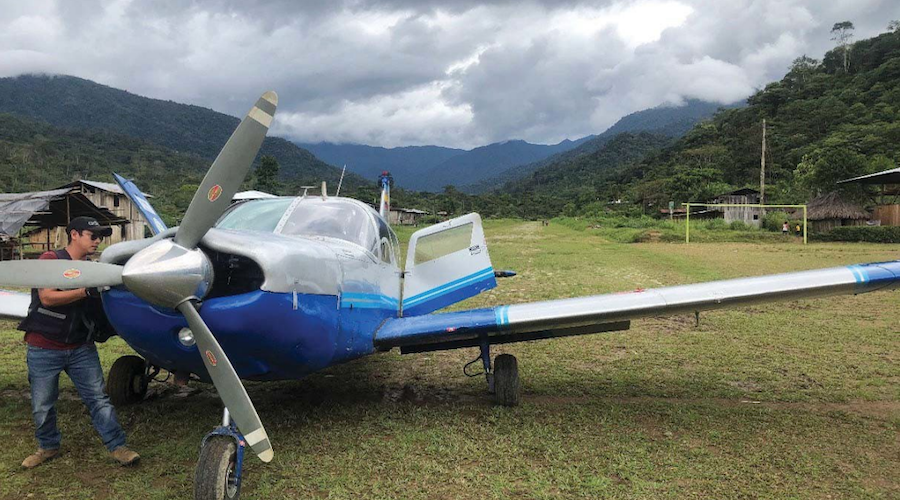

Solaris Resources (TSX:SLS)(NYSEAmerican:SLSR) on April 17, 2024 reached a significant milestone for its flagship Warintza Copper Project in southeastern Ecuador. The company signed an updated Impact and Benefits Agreement (IBA) with the Shuar communities of Warints and Yawi, reflecting the continued growth and advancement of the project and reaffirming the communities’ support for responsible development. Here’s what’s behind the agreement and why it is such a major milestone for the project and the country.
The updated IBA followed the Ecuadorian government’s publication of a manual demanding prior consultation with surrounding communities for existing and new mining projects. This agreement built upon the strategic alliance formed between Solaris and the Shuar communities in August 2019, which has fostered direct and transparent dialogue regarding all project-related activities.
The Warintza deposit, discovered by David Lowell in 2000, sat dormant for two decades due to a breakdown in social acceptance from local communities. In mid-2019, Solaris undertook extensive dialogue to understand and resolve the root causes of conflict, leading to the signing of initial impact and benefits agreements in 2020 and 2022.
Key highlights of the updated IBA include explicit community consent for the Warintza Project, legally binding and ensuring the communities are informed and engaged throughout the project’s lifecycle. The agreement also includes commitments and benefits to the communities, such as impact mitigation measures, local employment and training opportunities, education and skills training programs, investments in community infrastructure, and financial benefits and compensation for the use of ancestral lands.
The IBA is governed by an elected Board of Directors that operates as a regional task force, monitoring project activities, communicating with employees, and ensuring accountability of the commitments made between the State, Community, and Company.
Solaris president and CEO Daniel Earle stated, “The signing of this updated impact and benefits agreement marks a significant milestone in the social advancement of the Warintza project through our pioneering participatory mining model for sustainable resource development.”
The timeline of agreements between Solaris and the Shuar communities includes a Memorandum of Understanding signed in January 2019, the first Impact and Benefits Agreement in September 2020, an updated agreement in March 2020 for project advancement and scope expansion, and the completion of an Environmental Impact Assessment on the project in late 2022.
The updated IBA ultimately demonstrates Solaris Resources’ commitment to responsible and inclusive mining practices, ensuring that local communities are involved and benefit from the Warintza Copper Project’s advancement.
Ms. Sonsoles García, Minister of Production, Foreign Trade, Investment and Fisheries, commented, “We value this initiative of Solaris because it strengthens positive community relations and provides for the integration of the local population in productive and sustainable activities. This allows the inclusion of a traditionally displaced population, which is a priority for us. It is also aligned with the priority we have as a National Government of territorial development and good use and management of resources.”
Mr. Daniel Earle, President & CEO, commented, “The signing of this updated IBA builds on the foundation of good faith dialogue and trust that led to the formation of a Strategic Alliance partnership with our host communities and original IBA in 2020. This marks a significant milestone in the social advancement of the Warintza Project through our pioneering Participatory Mining model for sustainable resource development.”
Mr. Agustin Kayuk, leader of the Shuar Warints Center and member of the Board of Directors of the Strategic Alliance, commented, “The signing of this updated IBA strengthens the working relationship with Solaris and brings greater opportunities for the development of our communities. The decision is supported by a permanent relationship with the Company based on mutual respect and transparent dialogue, as well as a history of positive impacts generated for our people. We look forward to continuing our relationship and playing an integral role in the advancement of the Project.”
Mr. Vicente Froilan Juank, leader of the Shuar Yawi Center and also a member of the Board of Directors of the Strategic Alliance, commented, “The updated IBA brings further support and new opportunities for our people. When Warintza advances, our communities advance with it. Since the signing of the inaugural IBA in 2020, and with the help of the Ecuadorian state, the local impacts in job creation, community infrastructure, and development of programs in health, education, skills training, entrepreneurship, and innovation have been evident in our daily lives.”
The above references an opinion and is for information purposes only. It is not intended to be investment advice. Seek a licensed professional for investment advice. The author is not an insider or shareholder of any of the companies mentioned above.
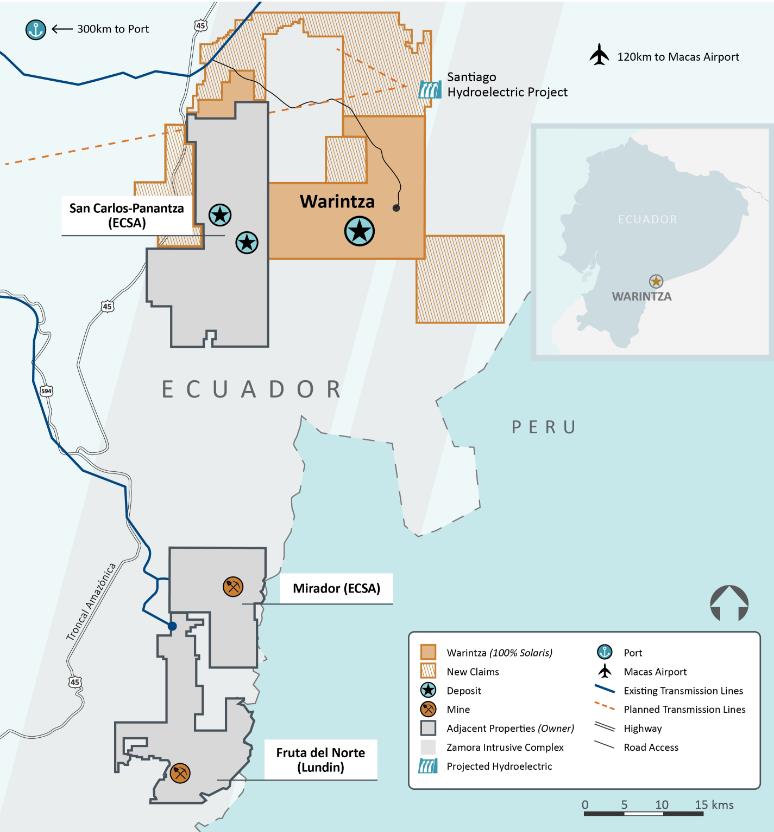


Solaris Resources (TSX:SLS) (NYSEAmerican:SLSR) has announced the termination of a previously proposed minority equity investment aimed at expanding the company’s Warintza Project in Ecuador.
The proposed investment, which would have supported both the growth of existing operations and the potential acquisition of a neighboring property, was initially announced four months ago. However, despite the anticipation of timely approval due to the minority nature of the investment and its focus on critical minerals, the transaction has not yet received the necessary regulatory clearance from Canadian authorities.
Solaris’ share price has also risen by over 35% since the initial announcement, making the terms of the investment, which included a 14% premium at the time, no longer financially advantageous for the company. This price increase, while positive in isolation, has been outpaced by similar companies in the sector due to the ongoing uncertainty surrounding the regulatory process in Canada.
The company has expressed disappointment in the delay, citing the evolved regulatory environment and heightened political sensitivity surrounding Canadian investments in foreign assets. The combination of these factors, coupled with the increasingly unattractive terms of the deal, has led Solaris to conclude that terminating the investment is the most prudent course of action to protect shareholder interests.
Despite this setback, Solaris remains financially secure, with sufficient funds to support its planned activities at the Warintza Project through 2025. This includes the ongoing exploration of a recently acquired 40,000-hectare area adjacent to the existing project site, which has already shown promising geological and geophysical similarities to the mineral-rich Warintza cluster.
Furthermore, the company has access to an additional US$40 million in funding through an existing offtake financing agreement. With these resources, Solaris intends to focus on maximizing shareholder value through a targeted strategy that prioritizes long-term growth and flexibility.
Solaris has also reiterated its commitment to the Warintza Project timeline, with an Environmental Impact Assessment expected to be delivered in the second half of 2024 and a Pre-Feasibility Study in the second half of 2025. These milestones are crucial steps in the development of the project, and Solaris remains optimistic about the potential of Warintza to become a significant source of critical minerals.
The above references an opinion and is for information purposes only. It is not intended to be investment advice. Seek a licensed professional for investment advice. The author is not an insider or shareholder of any of the companies mentioned above.



Solaris Resources Inc. (TSX:SLS)(NYSEAMERICAN:SLSR) has shared an operations update for its Warintza copper project in southeastern Ecuador. The update highlights improved productivity and cost savings under new Chief Operating Officer Javier Toro, as well as the appointment of top consultants to support the Environmental Impact Assessment (EIA) and Pre-Feasibility Study (PFS).
Mr. Javier Toro, COO, commented in a press release: “We are excited with the improvements we have made at site where our team is approaching record monthly drilling rates with significantly fewer rigs than at prior peaks. We are also pleased to be making progress in advancing studies and work programs to support the completion of the EIA in H2/24 and PFS in 2025. Warintza is a very unique project given its global scale and location in a mining district adjacent to infrastructure at low elevation.”
Drilling Ramps Up, Targeting 30km in 2024
Drilling at Warintza continues to accelerate, with six rigs completing over 5,400 meters in April, close to setting a new monthly record for the project. Solaris has budgeted a minimum of 30 kilometers of resource growth and infill drilling for 2024. Some of these holes will also provide technical data for mine design and planning to support upcoming technical studies.
The updated mineral resource estimate remains on track for completion at the end of June and release in early July. It will be completed by leading porphyry specialist Mr. Mario E. Rossi of Geosystems International Inc., who also conducted the previous estimate.
EIA Targeted for H2 2024, PFS for H2 2025
Solaris has engaged ESSAM Cía. Ltda., an Ecuadorian environmental consulting firm accredited by Ecuador’s Ministry of Environment, to finalize and submit the EIA for the Warintza exploitation phase. ESSAM has experience supporting Ecuador’s largest copper and gold mines. The EIA submission is targeted for the second half of 2024, building on over three years of baseline environmental monitoring, data collection and studies.
To support the PFS planned for the second half of 2025, Solaris has appointed leading international consulting firms:
– Ausenco Engineering for metallurgical studies, process plant design, and infrastructure assessments
– Knight Piésold Consulting for detailed technical studies and engineering designs for the pit, waste rock facility, and tailings management facility
– AMC Consultants and Minsys Mining Systems for mine scheduling and trade-off studies to optimize mine plans
Improved Site Productivity and Cost Savings
Infrastructure development, logistics optimization, and improved practices at the Warintza site have significantly increased productivity and efficiency. This has enabled a 26% reduction in drilling costs to US$229 per meter and generated substantial savings compared to the Q1 2024 budget.
Current Funding and Future Plans
As of March 31, Solaris held an unaudited cash balance of approximately US$29 million. An additional US$40 million is expected from the previously announced offtake financing package. These funds are expected to support the planned 2024 and 2025 work programs. Upon closing the strategic investment announced in January, Solaris plans to expand activities and continue the consolidation of the land package surrounding Warintza.
The above references an opinion and is for information purposes only. It is not intended to be investment advice. Seek a licensed professional for investment advice. The author is not an insider or shareholder of any of the companies mentioned above.
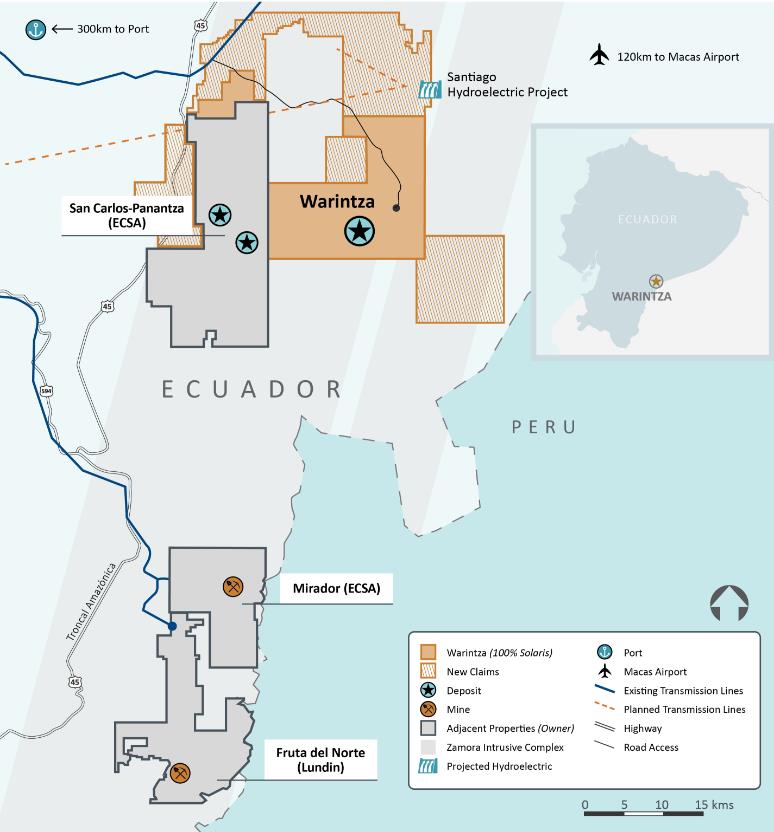

Solaris Resources (TSX: SLS)(NYSE:SLSR) has recently been awarded an option by Empresa Nacional Minera (ENAMI EP), Ecuador’s state-owned mining company, to acquire up to a 100% interest in 10 new exploration concessions. These concessions, covering approximately 40,000 hectares, are strategically located adjacent to the company’s existing Warintza Project and the San Carlos-Panantza porphyry copper-molybdenum deposits within the mineral-rich Zamora belt. This region is known for hosting some of Ecuador’s largest copper and gold mines to the south.
The newly acquired concessions are believed to hold significant potential for porphyry copper and epithermal gold deposits. This assessment is based on a comprehensive analysis of multiple layers of data, including Solaris’ extensive heliborne magnetic survey. The survey results, a portion of which is shown in Figure 2, reveal several promising indicators of mineral deposits.
Porphyry copper targets within the new concessions are characterized by open-ended annular magnetic highs surrounding magnetic lows and erosional depressions. These features are consistent with the outcropping deposits found within the Warintza porphyry cluster, suggesting a high likelihood of mineral presence.
Structural interpretation of the area supports the potential for epithermal gold deposits within dilational jogs and pull-apart basins. These geological settings are common for gold deposits in the Zamora belt and bear similarities to the Caya epithermal target, which was previously announced by Solaris in a press release dated April 23, 2024.
To expedite the exploration process, Solaris plans to deploy two field crews on the ground in May. These teams will begin conducting fieldwork to gather more detailed data and assess the mineral potential of the newly acquired concessions.
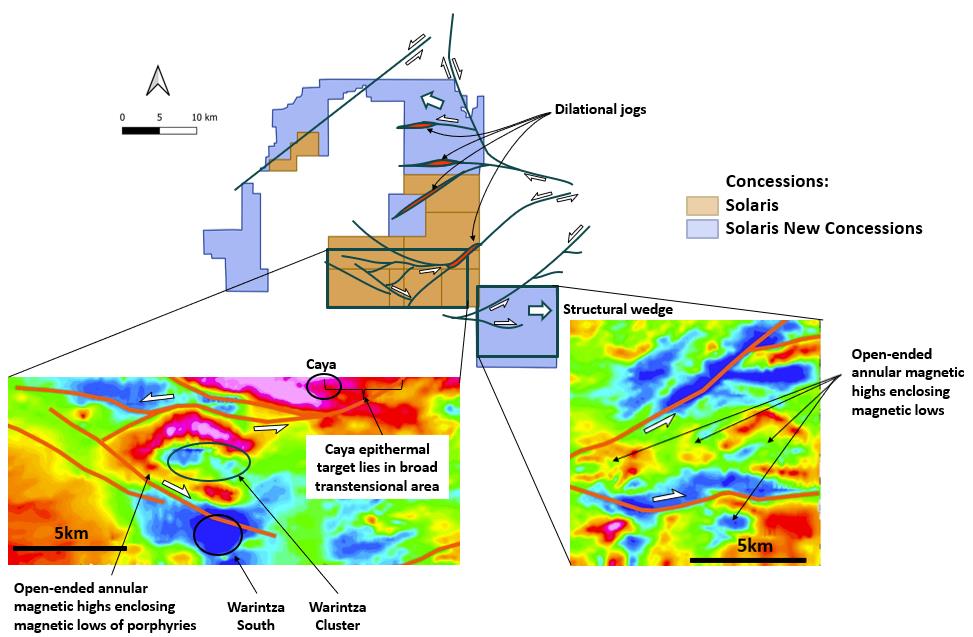

The terms of the agreement with ENAMI EP include an upfront payment of US$0.25 million, a proposed exploration program of up to US$25 million over the exploration phase, and the exclusive option for Solaris to acquire the claims from ENAMI EP at a price to be determined by independent experts. This agreement follows similar awards by ENAMI EP to subsidiaries of Barrick Gold Corporation and Hancock Prospecting Pty Ltd, which have committed to investing up to US$148 million in exploration programs in Ecuador.
Solaris’ acquisition of these new exploration concessions demonstrates the company’s commitment to expanding its presence in Ecuador’s thriving mining sector. With the promising potential for porphyry copper and epithermal gold deposits, Solaris is well-positioned to capitalize on the region’s mineral wealth and contribute to the country’s economic growth.
As fieldwork commences and more data becomes available, the mining industry and investors alike will be closely monitoring Solaris’ progress in unlocking the value of these new exploration concessions.
The above references an opinion and is for information purposes only. It is not intended to be investment advice. Seek a licensed professional for investment advice. The author is not an insider or shareholder of any of the companies mentioned above.
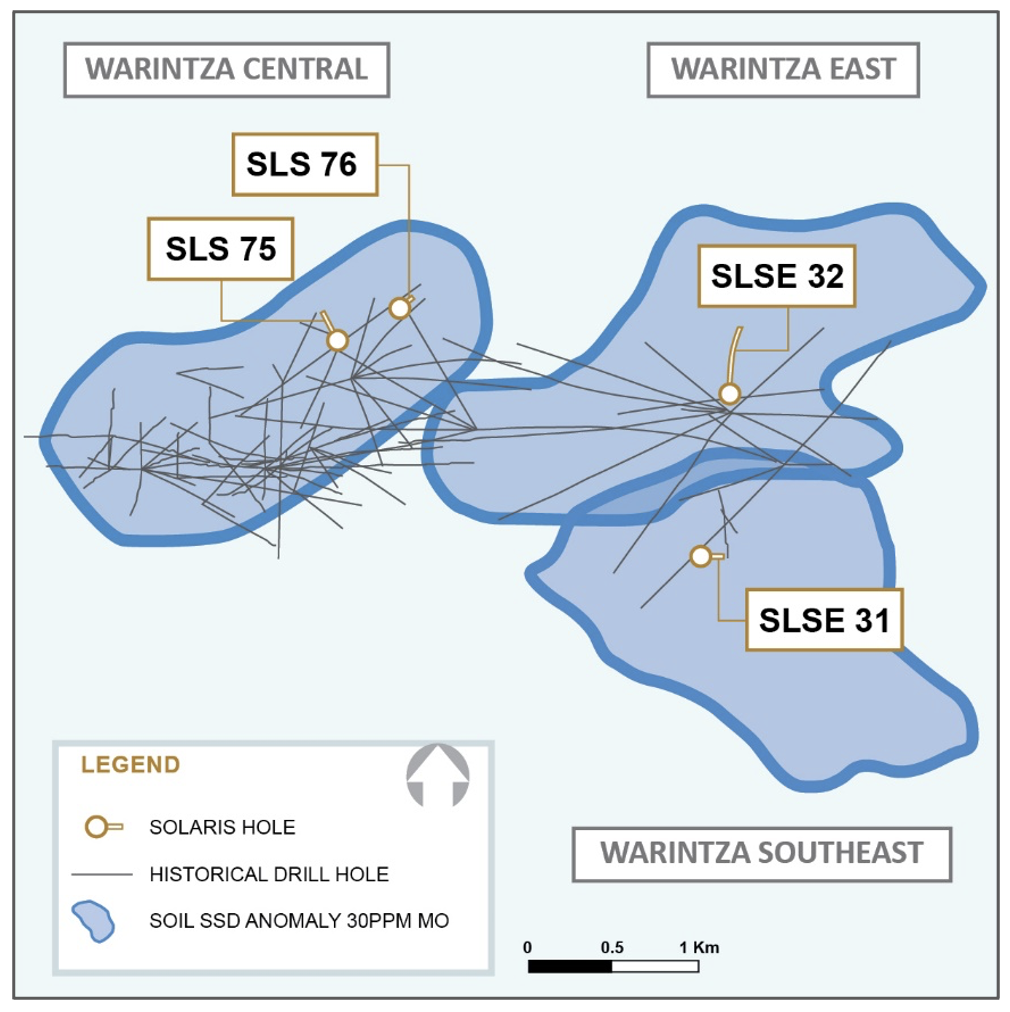

Solaris Resources (TSX:SLS) (NYSEAMERICAN:SLSR) has shared the initial results from its 2024 drilling efforts and provided an update on exploration at its Warintza Project in southeastern Ecuador. These early results include intersections of 150 meters of 0.67% copper equivalent (CuEq) within a broader section of 384 meters of 0.51% CuEq, and another segment measuring 284 meters of 0.53% CuEq starting near the surface.
The drilling operations, which intensified during the first quarter despite the rainy season, are part of a large-scale plan to both expand and upgrade the mineral resources at the project. With six rigs currently operating across multiple zones including Warintza Central, East, and Southeast, the company expects the drilling to continue throughout the year. This effort is also accompanied by exploratory drilling at the newly discovered Patrimonio site and regional exploration at the promising Caya epithermal gold target.
In terms of the 2024 drilling campaign specifics, January saw 700 meters drilled, which increased to 1,800 meters in February and 3,800 meters in March. The company anticipates reaching 5,200 meters by the end of April. Overall, Solaris plans to complete at least 30 kilometers of drilling this year, with an updated report on mineral resources expected by the end of June.
Solaris has secured the necessary funds for its 2024 and 2025 exploration programs through an offtake financing package announced in December last year. As of the end of 2023, the company reported having around US$39 million in cash and equivalents. It expects an additional US$40 million from its financing activities, further bolstered by a strategic investment finalized in January 2024. However, the details of this investment are still under review by Canadian regulators.
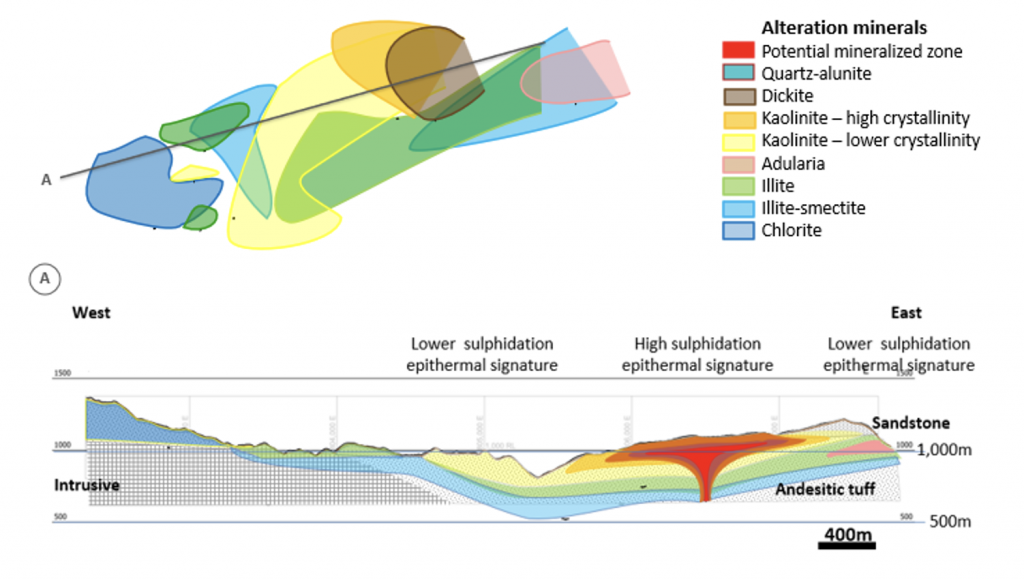

In addition to its drilling program, Solaris is also focusing on the Caya epithermal gold target. Recent field work at this site has highlighted a 5 km by 3 km gold anomaly located northeast of Warintza East. Soil samples have outlined a significant area of gold and other pathfinder elements indicative of epithermal mineral deposits. The alteration patterns and mineral assemblages found at Caya suggest a high-sulfidation epithermal system, a style of mineralization known for hosting significant gold deposits.
The exploration team has recently expanded its soil sampling grid to include areas affected by historical artisanal mining, which could offer insights into the broader mineral potential of the region. The company plans to use additional spectral analysis to better understand the alteration patterns in the volcanic sediment layers covering the target area. Further details on these findings are expected to be reported in June.
Highlights from the results are as follows:
- SLS-76 was collared on the northeastern limit of the Northeast Extension zone and drilled northwest, returning 150m of 0.67% CuEq¹ within a broader interval of 384m of 0.51% CuEq¹, before the hole was terminated in lower grade mineralization
- SLSE-31 was collared on the southern margin of Warintza Southeast and drilled east to the ~300m depth capacity of the KD-200 rig, returning 284m of 0.53% CuEq¹ from near surface, with the final 10m averaging 0.75% CuEq¹ and remaining open for extension drilling with a larger rig
- SLS-75, drilled northeast from a new 200m step-out platform at Northeast Extension zone, returned 26m of 0.52% CuEq¹ and 46m of 0.66% CuEq¹ within a low-grade section from surface with a post-mineral dyke before a final 62m mineralized interval averaging 0.51% CuEq¹
- SLSE-32 was collared on the northern margin of Warintza East and drilled north, returning 380m of 0.31% CuEq¹ from surface within a broader interval of 634m of 0.27% CuEq¹ where the hole cut the contact of the primary host lithology with bordering lower grade volcanic rock
- Exploration drilling is underway at Patrimonio to follow up on the discovery holes (144m of 0.50% CuEq¹ and 148m of 0.52% CuEq¹, respectively – refer to press release dated September 12, 2023) while field crews expand sampling coverage over the highest grade part of the anomaly to the south and down-dip of the replacement mineralization to locate the potential porphyry source
- Regional exploration programs are underway at the promising Caya epithermal gold target, located 6km to the northeast of Warintza East, where field crews are expanding sampling and alteration mapping to the west to cover an area where evidence of historical artisanal mining has been identified
- Funded for 2024 and 2025 programs with the offtake financing package announced in December, with plans to aggressively expand activities and consolidate the surrounding district with funds from closing the strategic investment announced in January



Solaris Resources (TSX:SLS)(NYSEAmerican:SLSR) and the Shuar communities of Warints and Yawi have recently signed an updated Impact and Benefits Agreement (IBA) for the Warintza Project. This agreement signifies a step forward in the project’s evolution, reflecting its continued growth and advancement.
The IBA is a key part of Solaris’ Community Social Relations (CSR) program, recognized as a leading practice within the Ecuadorian mining industry. It guarantees the Shuar communities’ backing for Warintza throughout all stages, from exploration and development to production. Importantly, the agreement also formalizes commitments to several key areas.
First, that Solaris Resources will uphold the social and cultural practices of the Shuar communities. Second, the company will take steps to minimize or eliminate any negative impacts the project may have. This could include environmental or social disruptions. To maximize community participation in the project, Solaris will provide opportunities for employment, education, and skills training. The agreement also includes financial benefits for the Shuar communities.
The Warintza Project is expected to deliver significant advantages to local communities. These include job creation and business development opportunities. The project will also improve access to appropriate healthcare, including emergency services. Additionally, the agreement includes measures to develop community infrastructure and provide educational and skills training programs.
The updated IBA also fosters greater involvement from the Shuar communities in the project’s development. This collaboration establishes a framework to address shared concerns regarding the project’s impact on their lives and the well-being of their communities.
Beyond local benefits, the Warintza Project is anticipated to generate tax revenue for the Ecuadorian government. Solaris has reiterated its commitment to operating sustainably and responsibly by minimizing environmental impact and maintaining open communication with local communities.
Ms. Sonsoles García, Minister of Production, Foreign Trade, Investment and Fisheries, commented, “We value this initiative of Solaris because it strengthens positive community relations and provides for the integration of the local population in productive and sustainable activities. This allows the inclusion of a traditionally displaced population, which is a priority for us. It is also aligned with the priority we have as a National Government of territorial development and good use and management of resources.”
Mr. Daniel Earle, President & CEO, commented, “The signing of this updated IBA builds on the foundation of good faith dialogue and trust that led to the formation of a Strategic Alliance partnership with our host communities and original IBA in 2020. This marks a significant milestone in the social advancement of the Warintza Project through our pioneering Participatory Mining model for sustainable resource development.”
Mr. Agustin Kayuk, leader of the Shuar Warints Center and member of the Board of Directors of the Strategic Alliance, commented, “The signing of this updated IBA strengthens the working relationship with Solaris and brings greater opportunities for the development of our communities. The decision is supported by a permanent relationship with the Company based on mutual respect and transparent dialogue, as well as a history of positive impacts generated for our people. We look forward to continuing our relationship and playing an integral role in the advancement of the Project.”
Mr. Vicente Froilan Juank, leader of the Shuar Yawi Center and also a member of the Board of Directors of the Strategic Alliance, commented, “The updated IBA brings further support and new opportunities for our people. When Warintza advances, our communities advance with it. Since the signing of the inaugural IBA in 2020, and with the help of the Ecuadorian state, the local impacts in job creation, community infrastructure, and development of programs in health, education, skills training, entrepreneurship, and innovation have been evident in our daily lives.”


Solaris Resources (TSX:SLS)(NYSEAmerican:SLSR) is gearing up for its debut on the NYSE American. The move involves the discontinuation of its listing on the OTCQB Venture Market, transitioning the trading of its common shares to a more prominent platform under the new ticker symbol “SLSR” starting April 19, 2024. This strategic shift aims to provide Solaris with enhanced visibility and accessibility to a broader base of institutional and retail investors.
The company, which will continue to be listed on the Toronto Stock Exchange under the ticker “SLS”, does not require its shareholders to take any immediate actions regarding this transition. However, those who have purchased shares through the OTCQB are advised to check their accounts to ensure their holdings are updated with the new ticker symbol following the change.
Recent Developments and Strategic Investments
Earlier this year, on January 11, Solaris announced a significant financial boost through a private placement investment from Zijin Mining Group Co., Ltd., amounting to approximately $130 million. This deal resulted in the issuance of over 28 million common shares at a price of $4.55 each, a 14% premium over the closing price on the TSX the day before the agreement was finalized. This transaction marked a substantial endorsement from Zijin, which now holds about 15% of Solaris’ common shares on a fully diluted basis.
Daniel Earle, President and CEO of Solaris, praised the partnership, highlighting Zijin’s remarkable growth and expertise in the mining sector, which spans across 16 countries. The collaboration is set to advance the development of Solaris’s flagship Warintza Project in southeastern Ecuador, with funds also earmarked for general corporate purposes.
The closing of the private placement is contingent upon several conditions, including approvals from the TSX, under the Investment Canada Act, and from relevant authorities in China. Furthermore, the agreement grants Zijin the right to nominate a director to Solaris’s board as long as it maintains at least a 5% shareholding. Zijin also secures rights to maintain its ownership percentage through future securities purchases under specific conditions.
Trilateral Cooperation for Community Development
Additionally, on March 1, Solaris Resources further demonstrated its commitment to sustainable practices by entering a trilateral cooperation agreement aimed at supporting the Shuar communities in Ecuador. This initiative, involving the Interprovincial Federation of Shuar Centers and the Alliance for Entrepreneurship and Innovation, focuses on various developmental programs ranging from health and education to sustainable mining practices.
The collaboration aligns with ongoing efforts to promote economic and social advancement within these indigenous territories, which are integral to the Warintza Project’s success. The comprehensive support from this agreement encompasses health care, education, and business development programs tailored to the needs of the Shuar people, fostering a supportive relationship between the corporation and the community.
As Solaris Resources transitions to a new stage of corporate and community development, the company remains focused on leveraging strategic partnerships and maintaining its commitment to sustainable mining practices, positioning itself for future growth in the global mining sector.
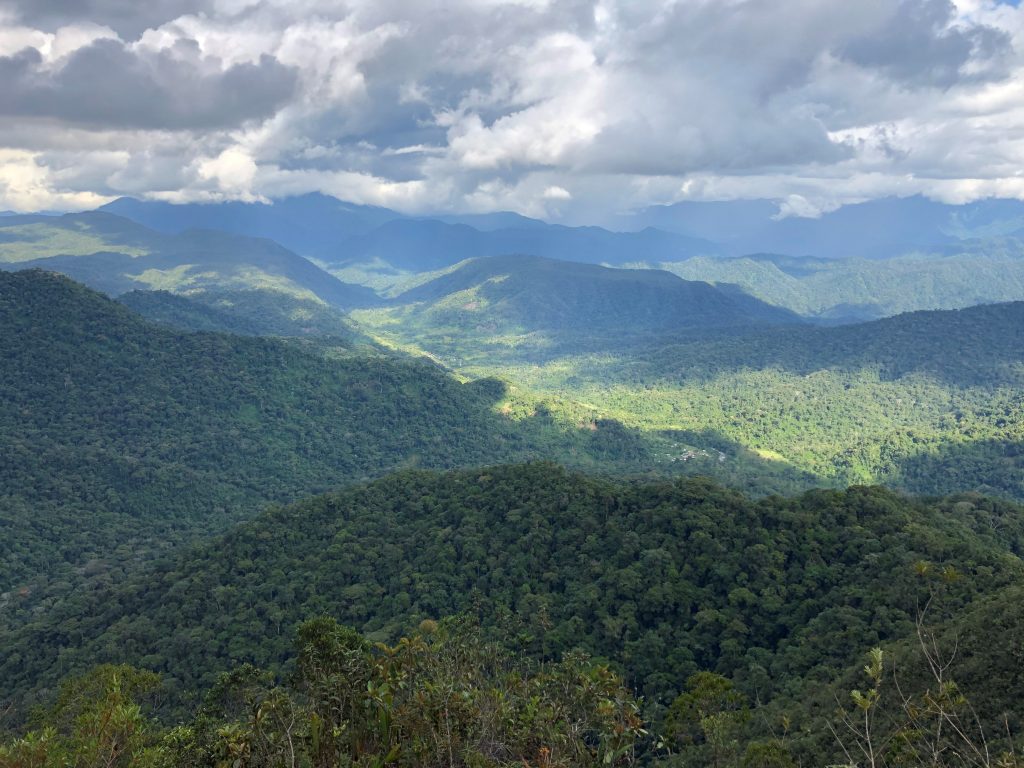

Solaris Resources (TSX: SLS) (OTCQB:SLSSF), on March 1, 2024, entered into a trilateral cooperation agreement with the Interprovincial Federation of Shuar Centers (FICSH) and the Alliance for Entrepreneurship and Innovation (AEI) of Ecuador. The signing ceremony took place during the Prospectors & Developers Association of Canada (PDAC) convention. What does the agreement mean for the company and the communities in which its Warintza Project operates?
The agreement aims to foster economic and social development in Shuar communities represented by FICSH, including the Warints and Yawi communities, which host Solaris’ Warintza Project on their lands. The collaboration will focus on programs in health, education, skills training, entrepreneurship, innovation, and sustainable mineral resource development.
FICSH, established by the Ministry of Social Welfare of Ecuador in 1964, is the largest and highest authority among Shuar indigenous organizations. It represents 50 associations, comprising 500 Shuar communities and approximately 143,000 Shuar indigenous people.
AEI is an independent non-profit organization dedicated to promoting entrepreneurship and innovation as the foundation for Ecuador’s productive development. Solaris has been a member of AEI’s network of public, private, and academic actors since 2021.
Mr. Froilan Juank, President of Yawi Center and member of the Board of Directors of the Strategic Alliance, commented in a press release: “The Shuar communities of Warints and Yawi support this agreement which follows from our request for FICSH to represent us and our interests and extend benefits to other member communities. We reject the false statements made by foreign non-governmental organizations (NGOs) and the Shuar Arutam People’s Associations (PSHA) which ignore our voice and speak against our interests. We are the legitimate registered owners of the Ancestral Lands on which the Warintza Project resides and we have the right and have chosen, through our General Assembly, to participate in the project through our Strategic Alliance and Impact and Benefits Agreement.”
Mr. David Tankamash, President of FICSH, commented in a press release: “Our work aims to improve the quality of life and access to opportunities for our member Shuar Centers. We support the Warints and Yawi communities and reject the efforts of foreign NGOs who act against the will and interest of our members. This agreement, which has been approved by the will of the FICSH General Assembly, is important for inclusive and sustainable mineral resource development. The Solaris model proves the Shuar nation can partner in development opportunities on our lands. We deserve the opportunities indigenous nations have in other parts of the world and foreign NGOs must respect our choices.”
The key programs under the cooperation agreement include:
- Health: Training and support for providing medical services in remote communities, in collaboration with the Ministry of Public Health.
- Education: Training and support for developing and delivering intercultural education in remote communities, in partnership with the Ministry of Education.
- Production: Training and technical assistance related to agricultural and business development, project management, and accounting.
- Artisanal mining: Environmental, safety, and technical training and support for the formalization of artisanal mining in FICSH territories.
The agreement also demonstrates Solaris Resources Inc.’s commitment to engaging with local communities and promoting sustainable development in the regions where it operates.
The above references an opinion and is for information purposes only. It is not intended to be investment advice. Seek a licensed professional for investment advice. The author is not an insider or shareholder of any of the companies mentioned above.
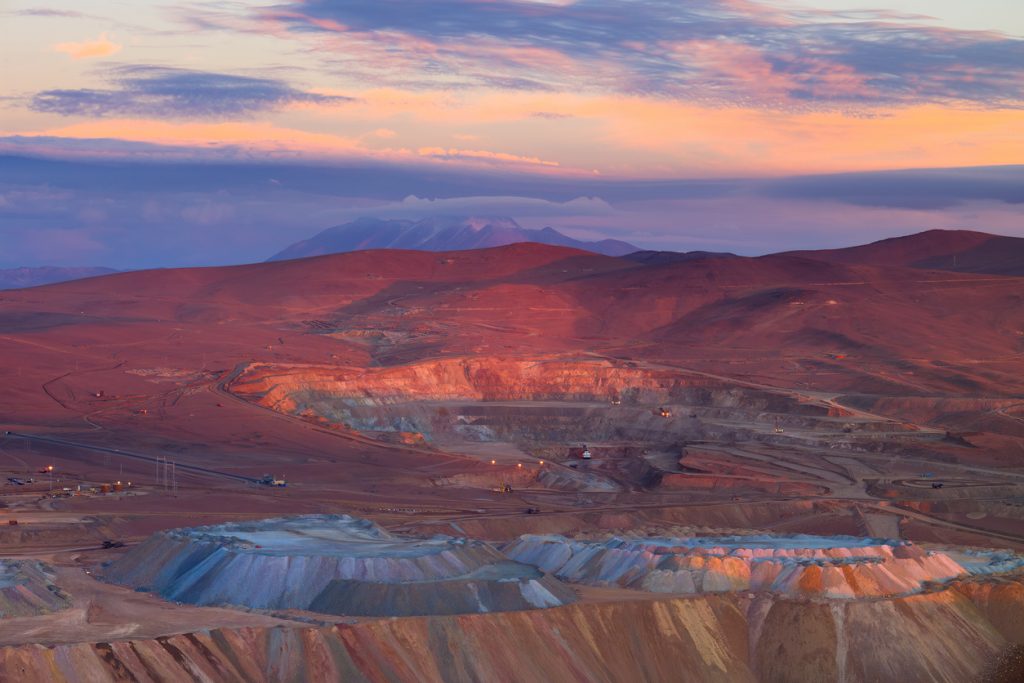

The copper mining industry plays a crucial role in the global economy, with South America being a significant contributor to the world’s copper supply. As the demand for copper continues to grow, driven by the increasing need for renewable energy and electric vehicles, exploration projects in this region have gained momentum along with some of the biggest investment interest in the past few years . In 2024, there are a few important companies actively engaged in copper exploration across various countries in South America, with promising results and future prospects.
Freeport McMoRan in Peru
Freeport McMoRan, a leading copper producer, operates the Cerro Verde copper mine in Peru. However, the company is projected to face challenges in 2024, with sales volumes expected to decrease to 1.13Blb (512,559t) of copper, compared to 1.20Blb sold in 2023. This decline is attributed to lower grades at Cerro Verde and mill recoveries falling below those in the same period of 2022. Despite these challenges, Freeport McMoRan remains committed to its operations in Peru and continues to explore opportunities for growth and optimization.
Lundin Mining Corporation: Consistent Performance and Expansion
Lundin Mining Corporation has demonstrated consistent performance in its copper exploration and production activities across South America. In the second quarter of 2023, the company produced 10,697 tonnes of copper and approximately 13,000 ounces of gold in concentrate. The Chapada mine in Brazil, one of Lundin’s key assets, achieved higher recoveries, resulting in increased copper production compared to the prior year quarter.
Looking at Lundin’s historical performance, the company produced 249,659 tonnes of copper on a consolidated basis in 2022, which was within the guidance range of 250,000 to 274,000 tonnes. In 2023, Lundin Mining achieved a record consolidated copper production of 314,798 tonnes, surpassing the guidance range of 300,000 to 320,000 tonnes.
For the three-year period from 2024 through 2026, Lundin Mining has provided production guidance for copper, with a range of 366,000 to 400,000 tonnes. This guidance is largely in line with the company’s 2023 production guidance, indicating a likely stable outlook for Lundin’s copper exploration and production.
Solaris Resources: Strategic Investments and Resource Expansion
Solaris Resources (TSX:SLS) (OTCQB:SLSSF) has proven itself as one of the most important exploration companies in South America over the past few years, with significant developments at its Warintza Project in Ecuador. The company is preparing for a major mineral resource estimate update, expected in late Q2 2024, which will leverage extensive drilling data to potentially enhance resource size and grade at Warintza Central, East, and Southeast.
In a strategic move, Solaris also announced plans to list its common shares on the NYSE American stock exchange, securing funding for exploration and development programs in 2024 and 2025. Additionally, the company received a significant investment from Zijin Mining, a major Chinese company, which provided crucial capital for ongoing activities at the Warintza Project and highlighted the project’s potential.
Zijin Mining’s investment, announced on January 11, 2024, involves the purchase of approximately 28,481,289 common shares of Solaris Resources at a subscription price of $4.55 per share, representing a 14% premium to the closing price of the common shares on the Toronto Stock Exchange (TSX) on January 10, 2024. Upon closing of the investment, Zijin Mining will own approximately 15% of the common shares on a fully diluted basis.
The investment from Zijin Mining is expected to be used by Solaris Resources to advance and develop the Warintza copper project primarily. This strategic partnership provides financial security for Solaris Resources and the expertise and growth potential of Zijin Mining, one of the most successful major mining companies in the world.
Solaris Resources continues active drilling with six rigs, focusing on resource expansion, infill drilling, and exploration beyond the current resource zones\[2\].
Copper exploration in South America remains strng in 2024, with companies like Freeport McMoRan, Lundin Mining Corporation, and Solaris Resources actively engaged in resource expansion, strategic partnerships, and sustainable operations. As the demand for copper continues to grow, driven by the global shift towards renewable energy and electric vehicles, these projects will be watched ever more closely for major announcements.
The above references an opinion and is for information purposes only. It is not intended to be investment advice. Seek a licensed professional for investment advice. The author is not an insider or shareholder of any of the companies mentioned above.


The Warintza Project in southeastern Ecuador, operated by Canadian copper mining company Solaris Resources (TSX:SLS) (OTCQB:SLSSF), has become a model for sustainable mineral exploration and development. Solaris adheres to a “Participatory Mining” model that engages government, communities, and the company in an alliance governing the strategic socio-economic development alongside the project. This inclusive approach is based on transparency, dialogue, and building trust between stakeholders with the goal of improving quality of life in a sustainable manner.
For example, the company has explicit community consent for the Warintza Project through legally-binding community agreements with the Warints and Yawi Shuar communities that host the Project on their Ancestral Lands. These Ancestral Lands are legally-defined and have been registered with the Government of Ecuador since 2002. The timeline of agreements includes:
- January 2019: Memorandum of Understanding signed with the Warints and Yawi communities
- September 2020: Impact and Benefits Agreement, the first signed in the country with Shuar communities
- March 2020: Impact and Benefits Agreement for Project advancement and scope expansion
- Late 2022: Completed an Environmental Impact Assessment on the Project
This formal consent demonstrates the strong relationship and trust built between Solaris and the local communities through open dialogue and mutually beneficial partnerships. The participatory model ensures the indigenous populations are informed, engaged, and ultimately benefit from the development of their ancestral territory.
Solaris’ commitment to sustainability is also embedded in its policies and participation in the UN Global Compact. They strive to minimize environmental impacts by going beyond required guidelines, using robust monitoring, and integrating protection into daily practices. Compliance with regulations, biodiversity management, community involvement, efficient resource use, responsible waste management, and education on best practices foster environmental stewardship. Proactive efforts like their greenhouse gas reduction plan and partnerships demonstrate Solaris’ dedication.
Central to the sustainability strategy is the Citizen Participation Process where local populations are informed of potential impacts and can provide input that gets incorporated into environmental studies. This participatory mechanism for consultation and dialogue ensures community engagement and consent, legitimizing the project. Solaris maintains high corporate governance standards so decisions align with their core values of sustainable development.
The 2024 drilling program at Warintza recently commenced, with plans to have six rigs operating by February. An updated mineral resource estimate is expected by late Q2/24, likely showing major growth. Drilling will continue beyond this as permitted, with some holes serving other purposes like metallurgical testing. Exploration is also underway regionally to define additional drill targets.
Solaris also recently closed US$40 million in financing, including equity and initial drawdown of their debt facility, to fund 2024-2025 baseline programs. The major C$130 million strategic investment by Zijin Mining Group will allow aggressive expansion of programs this year to significantly advance the project. The partnership with successful global miner Zijin will provide technical expertise and capacity to realize Warintza’s potential as a premier copper district.
Solaris’ ethical, sustainable model aligned with their financing strategy demonstrates a promising approach for the future of mineral development. The Warintza Project aims to create value responsibly and improve local communities, setting a positive example for the industry.
The above references an opinion and is for information purposes only. It is not intended to be investment advice. Seek a licensed professional for investment advice. The author is not an insider or shareholder of any of the companies mentioned above.
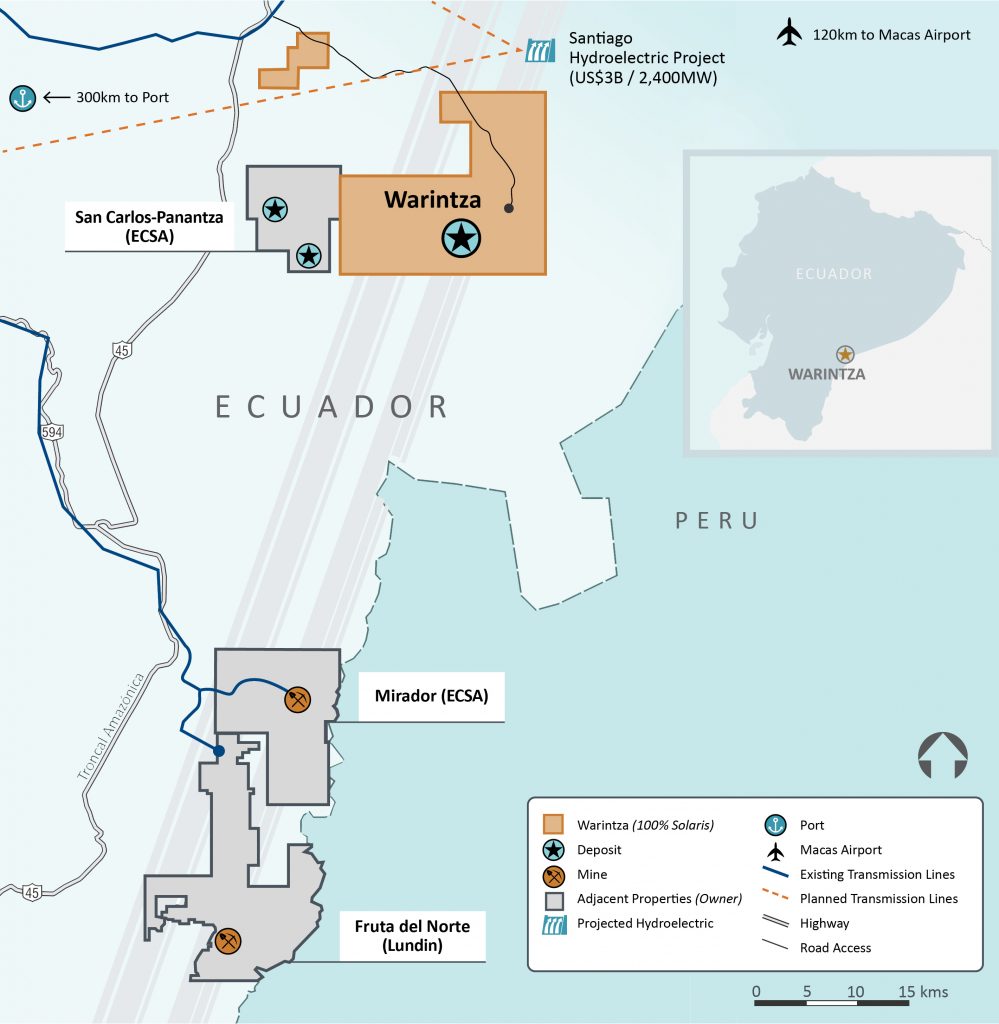

Solaris Resources (TSX:SLS) is preparing for a significant update to its mineral resource estimate for its flagship Warintza Project in southeastern Ecuador. The announcement, made in early January, comes in the middle of an ongoing drilling program and broader developments aimed at advancing the project towards potential development. What’s next for the project, and what are investors waiting for in 2024?
Mineral Resource Estimate Update in Sight
Investors and stakeholders are now waiting for the updated mineral resource estimate, expected in late Q2 2024. This revision will leverage nearly double the drilling data compared to the previous estimate, potentially leading to substantial growth in resource size and grade. The focus areas include Warintza Central, East, and Southeast, where drilling has targeted resource expansion and infill drilling.
A key aspect of the update is the incorporation of a “common pit shell,” which considers the economic viability of extracting all resources within a defined open pit. This approach provides a more realistic picture of the potentially mineable portion of the deposit and is will be critical for future development planning.
Active Drilling Campaign
Solaris is currently executing an ambitious drilling program for 2024, utilizing six drill rigs. This program serves a dual purpose:
- Resource expansion and infill drilling: This component directly supports the upcoming mineral resource estimate update by gathering additional data to refine geological understanding and resource definition.
- Exploration beyond the current resource: Drilling extends outwards from known zones, targeting areas with promising indications of copper mineralization. This proactive approach aims to identify new zones that could contribute to further resource growth in the future.
Beyond Warintza Central, exploration efforts are ongoing in other prospective areas within the project’s broader footprint. These regional activities add another layer to the ongoing exploration story at Warintza.
NYSE American Listing and Financial Backing Signal Confidence
In another significant development, Solaris announced plans to list its common shares on the NYSE American stock exchange. This move is expected to broaden the company’s investor base, particularly attracting interest from the U.S. market.
Financially, Solaris secured funding for its 2024 and 2025 exploration and development programs, ensuring continued momentum at Warintza. This financial backing highlights the company’s commitment to advancing the project and realizing its full potential.
The company’s progress at the Warintza Project received a significant boost in January 2024 with a strategic investment of $130 million from Zijin Mining Group Co., Ltd., a major Chinese mining company. This financing agreement provides crucial capital for ongoing exploration and development activities and represents a strong vote of confidence in the project’s potential.
Under the terms of the deal, Zijin acquired approximately 28.5 million common shares of Solaris at a subscription price of $4.55 per share, representing a 14% premium to the market price at the time. This translates to an ownership stake of roughly 15% for Zijin, granting them a seat on the Solaris board of directors.
The importance of this financing is threefold:
- Financial Security: The $130 million injection directly supports the company’s ambitious plans for 2024 and 2025, including the ongoing drilling program, resource estimation update, and potential future studies. This financial security allows Solaris to focus on advancing the project without immediate funding concerns.
- Strategic Partnership: Zijin’s expertise in developing large-scale copper projects offers valuable insights and potential collaboration opportunities for Solaris. This partnership could prove crucial in navigating the complexities of future development stages.
- Market Validation: The significant investment from a major player like Zijin serves as a strong validation of Warintza’s potential. This positive endorsement could attract further interest from investors and stakeholders, broadening the project’s support base.
Overall, the Zijin financing deal represents a critical milestone for Solaris and the Warintza Project and secures the necessary resources for continued progress.
The Warintza Project also holds the potential to bring significant benefits to Ecuador. Responsible development post-exploration could create many more jobs, stimulate the local economy, and generate tax revenue for the government. Solaris has continued to emphasize its commitment to operating in a sustainable and responsible manner, minimizing environmental impact and engaging with local communities.
Looking Ahead: Milestones and Continued Progress Expectations
The release of the updated mineral resource estimate in late Q2 2024 stands as a major milestone for the Warintza Project. This event will provide valuable insights into the project’s size, grade, and economic potential. Depending on the results, further studies such as preliminary economic assessments or feasibility studies could follow, outlining a potential path towards development.
Solaris remains focused on advancing the Warintza Project through ongoing exploration, resource definition, and potential future development activities. With a significant update on the horizon, active drilling underway, and a secured financial position, the world is watching for the next news update.
The above references an opinion and is for information purposes only. It is not intended to be investment advice. Seek a licensed professional for investment advice. The author is not an insider or shareholder of any of the companies mentioned above.
If you would like to receive our free newsletter via email, simply enter your email address below & click subscribe.
CONNECT WITH US
Tweets
Tweet with hash tag #miningfeeds or @miningfeeds and your tweets will be displayed across this site.
MOST ACTIVE MINING STOCKS
Daily Gainers
          |
CMB.V | +900.00% |
          |
EOX.V | +100.00% |
          |
GRI.V | +100.00% |
          |
HBK.V | +50.00% |
  |
ZEU.AX | +50.00% |
          |
XTM.V | +42.86% |
          |
MTB.V | +33.33% |
          |
NEV.V | +33.33% |
          |
CASA.V | +30.00% |
          |
AFM.V | +28.33% |











